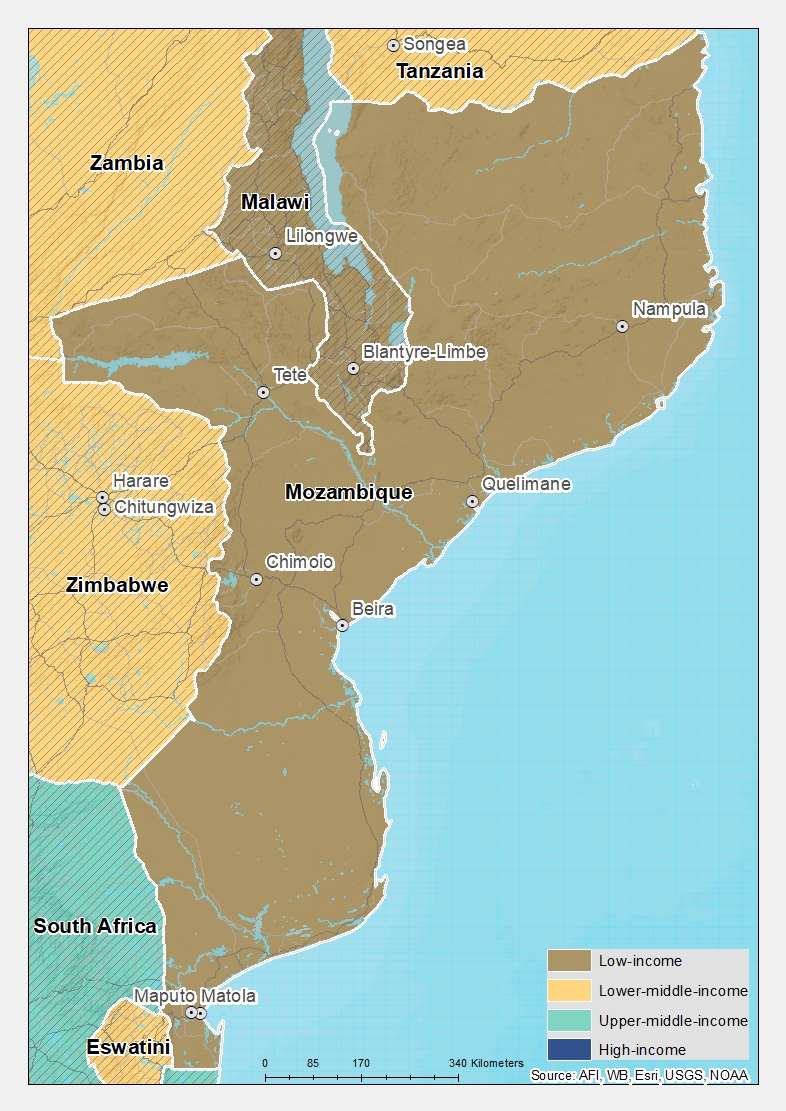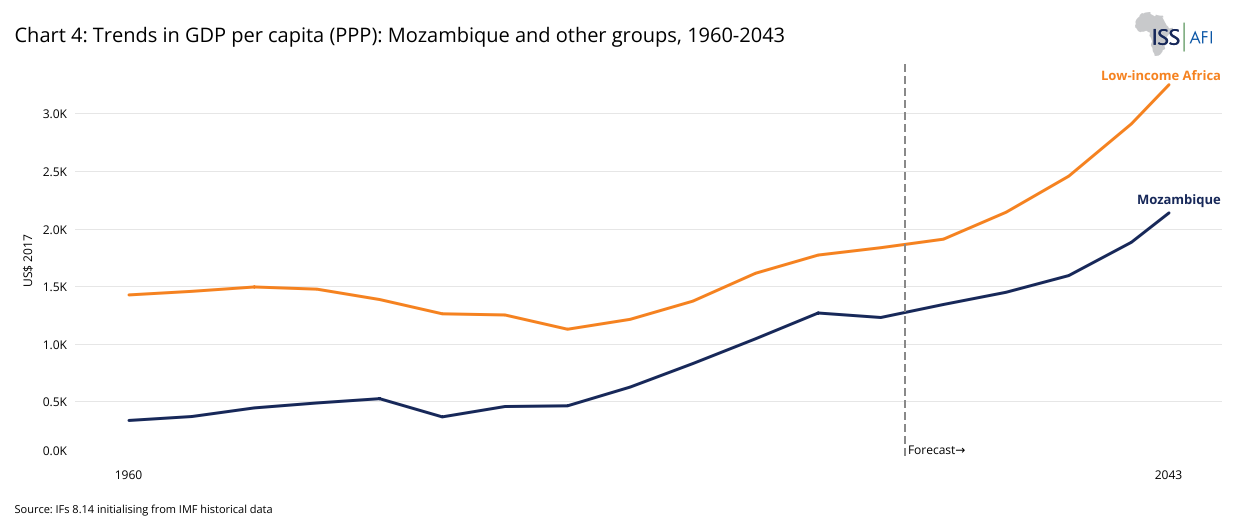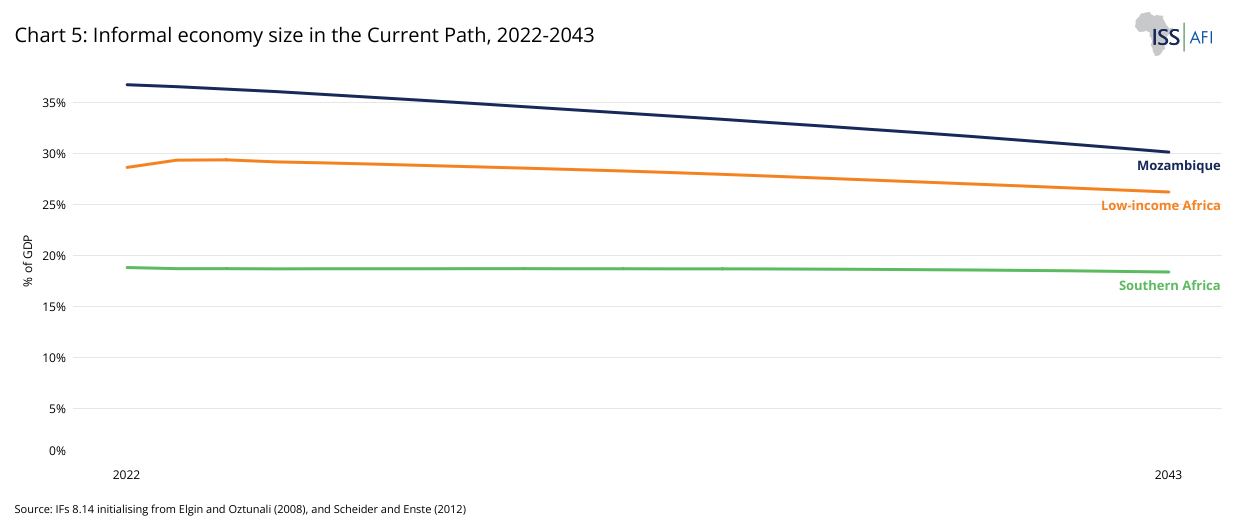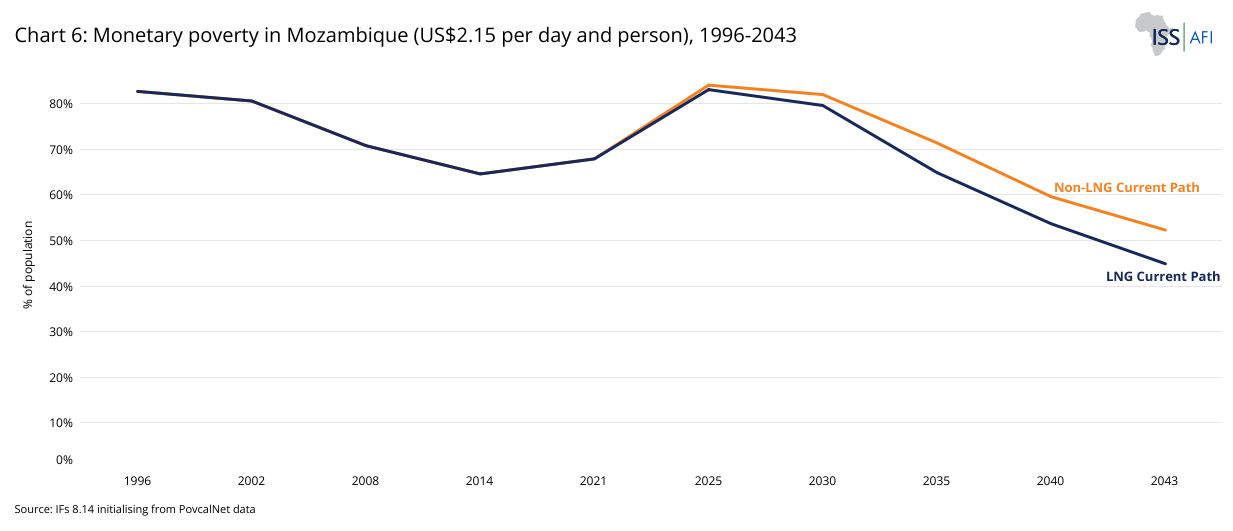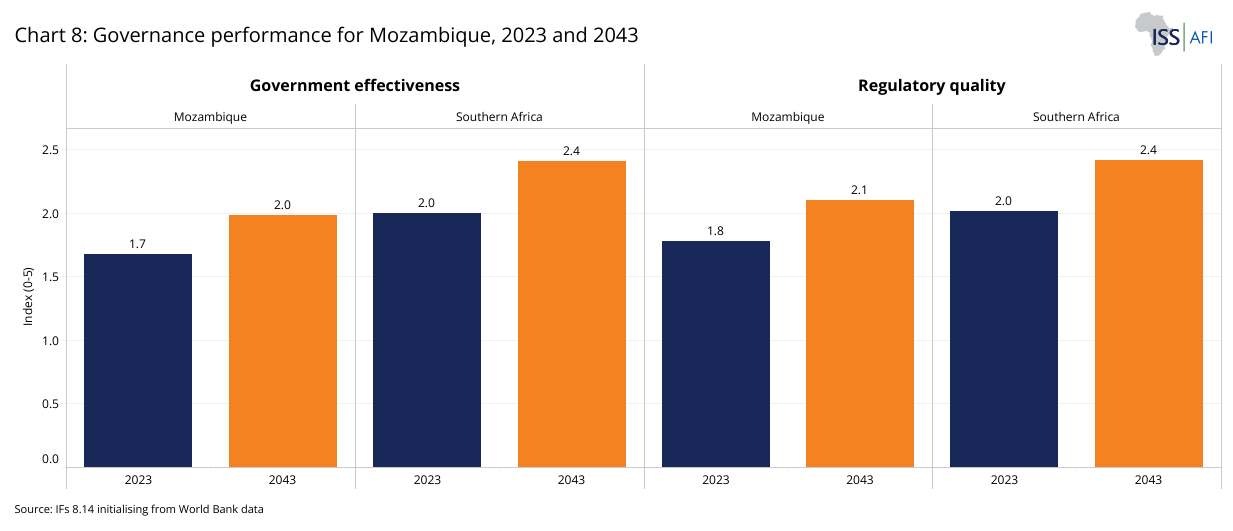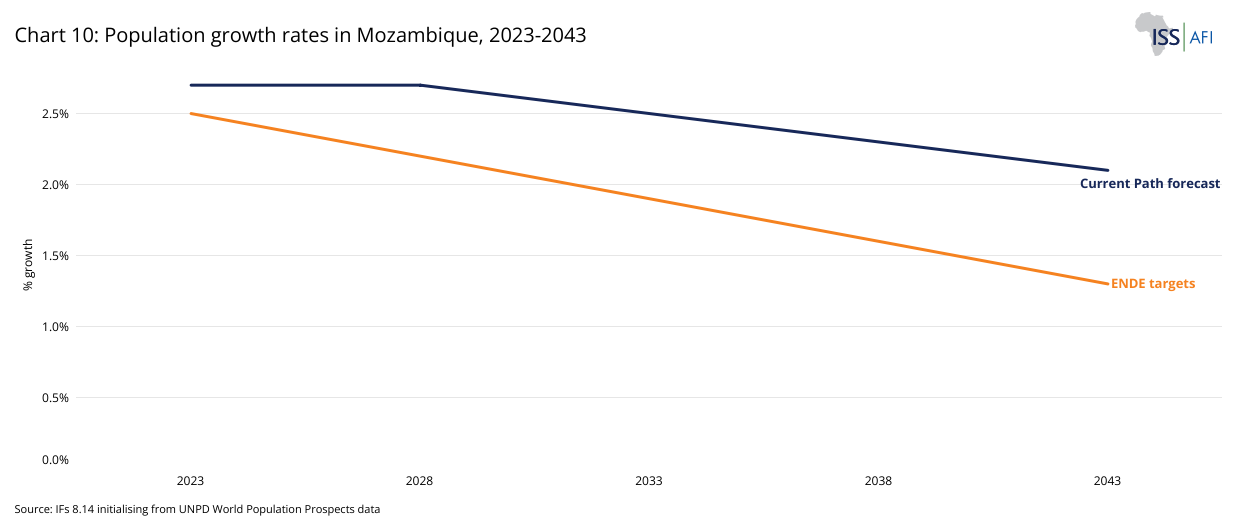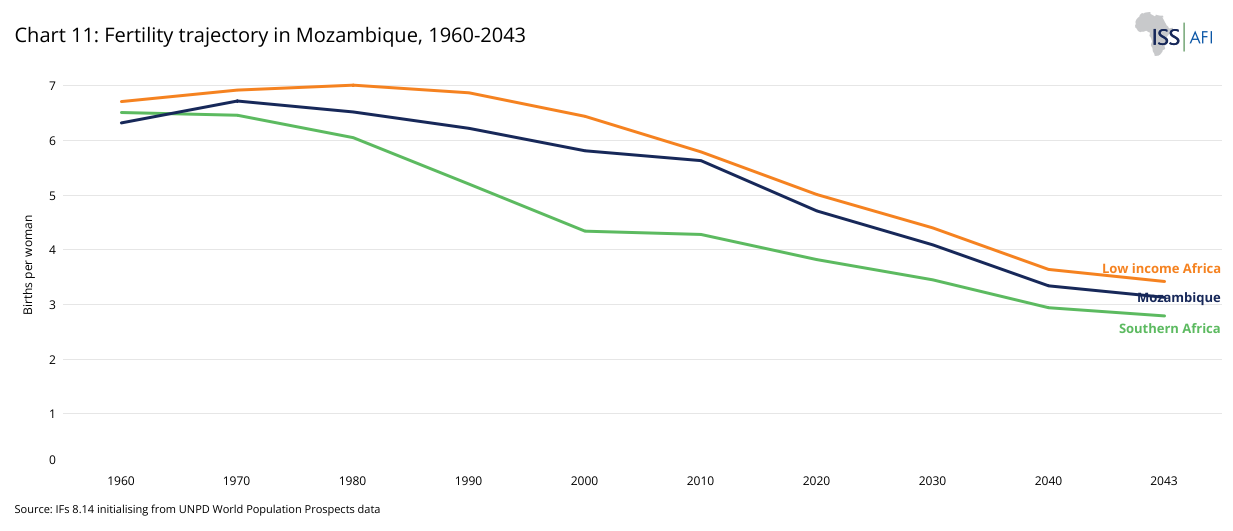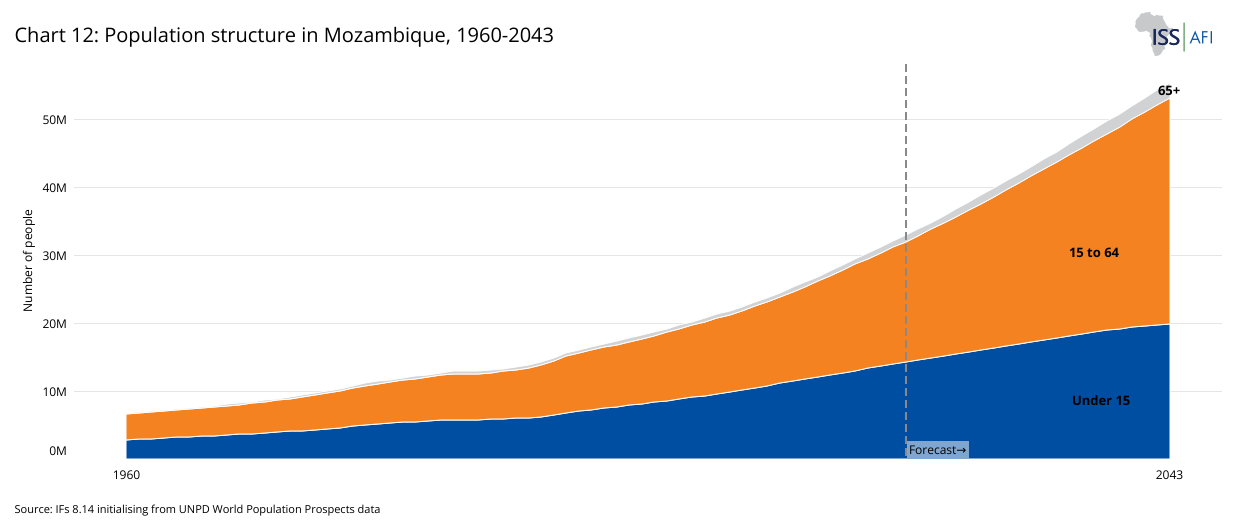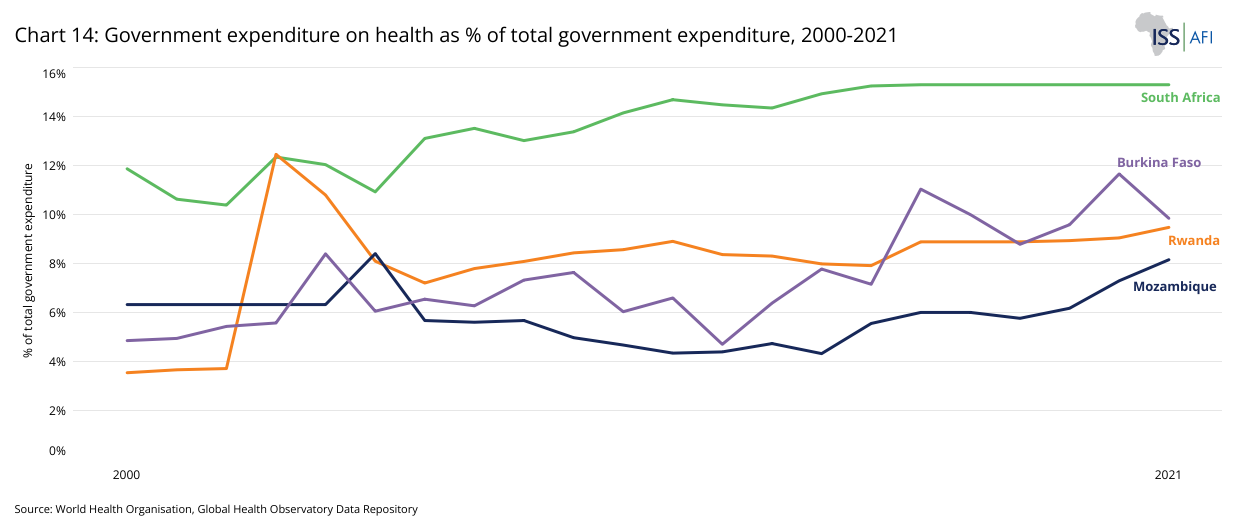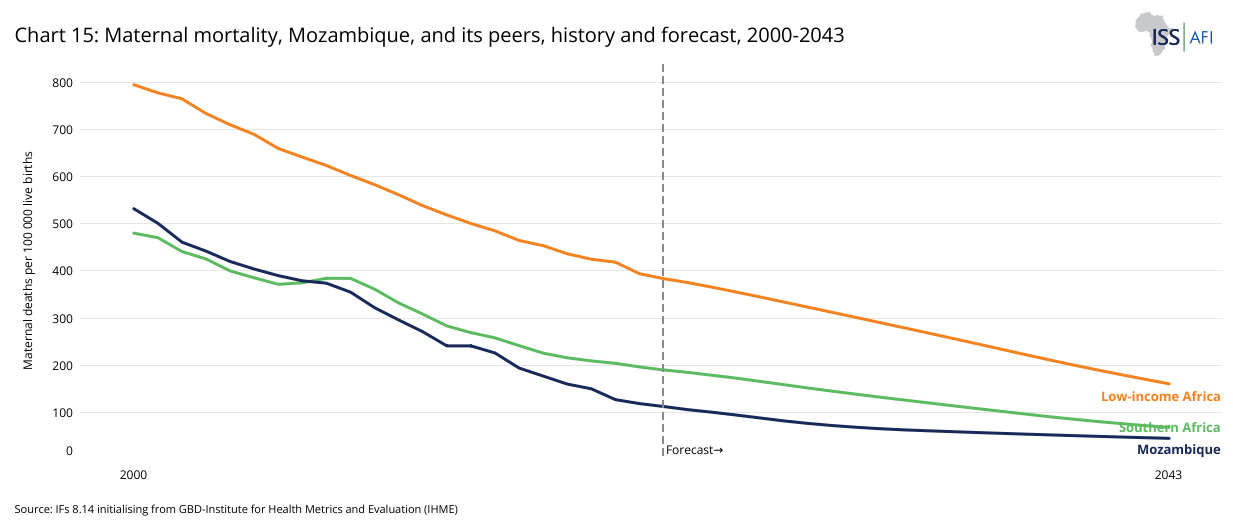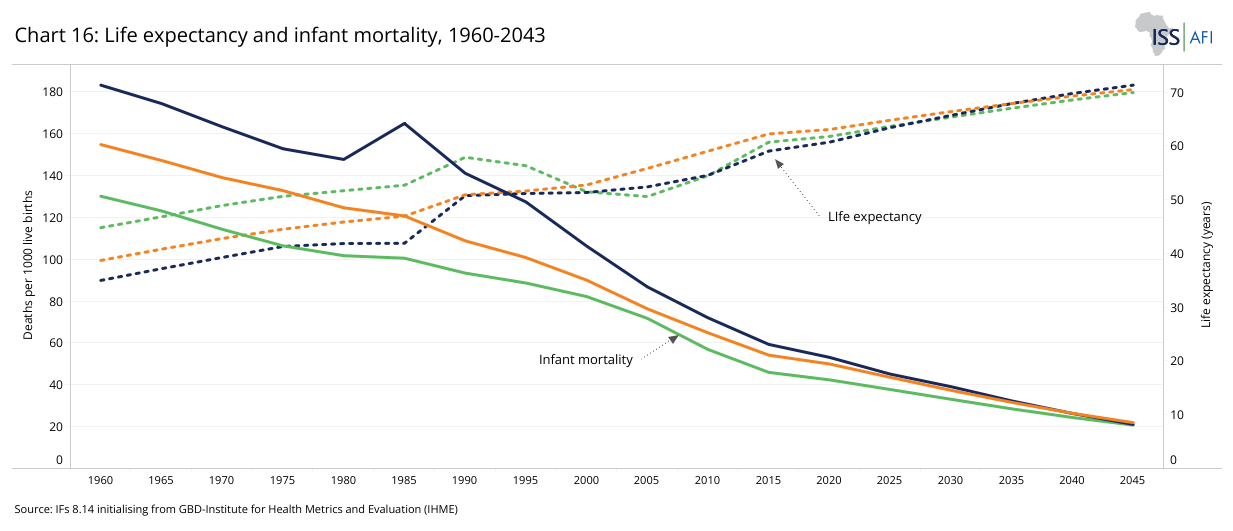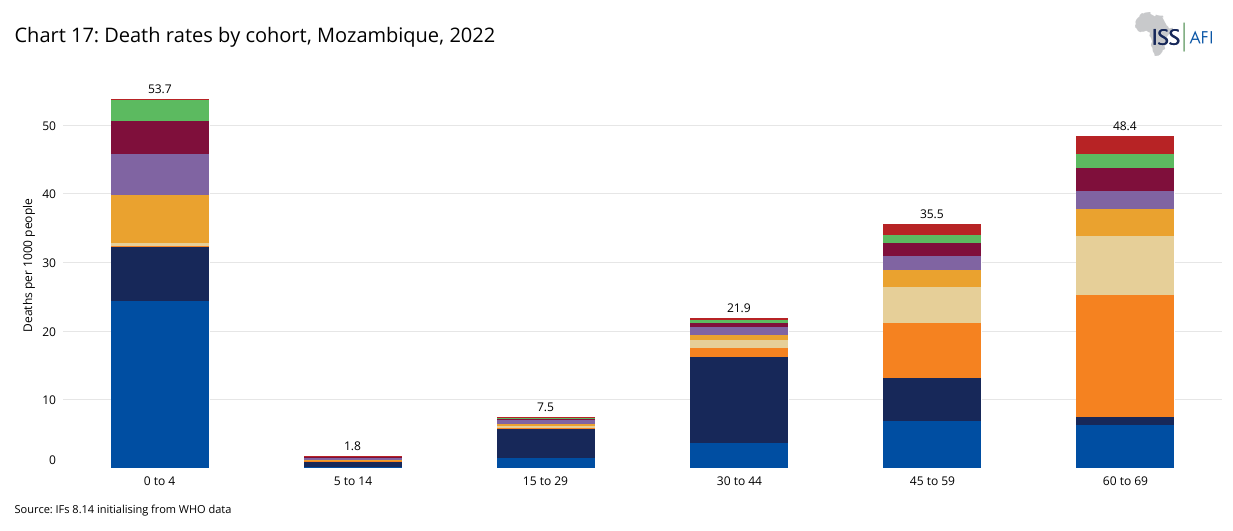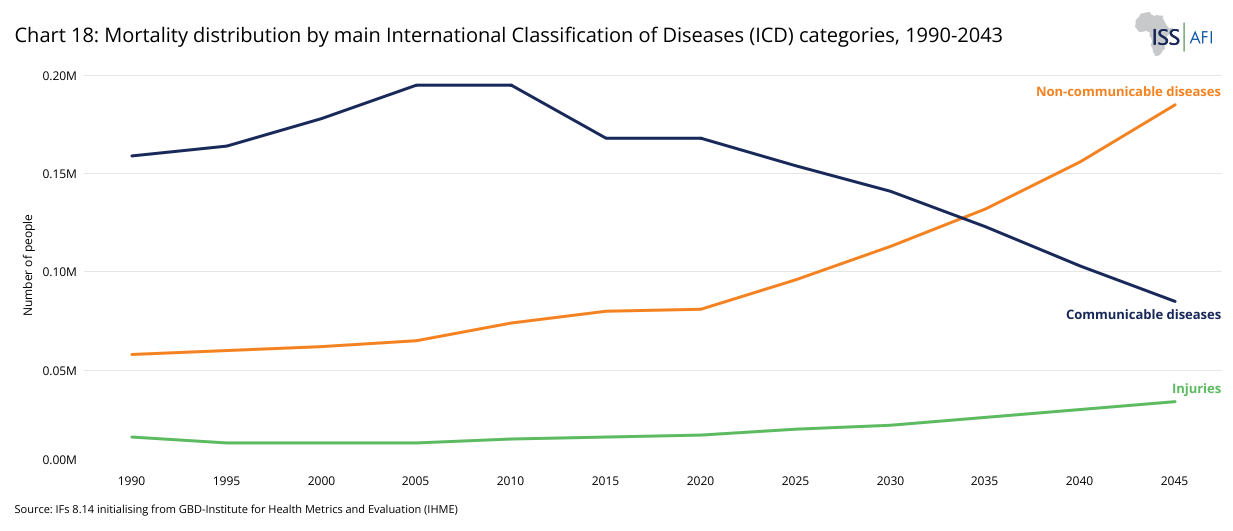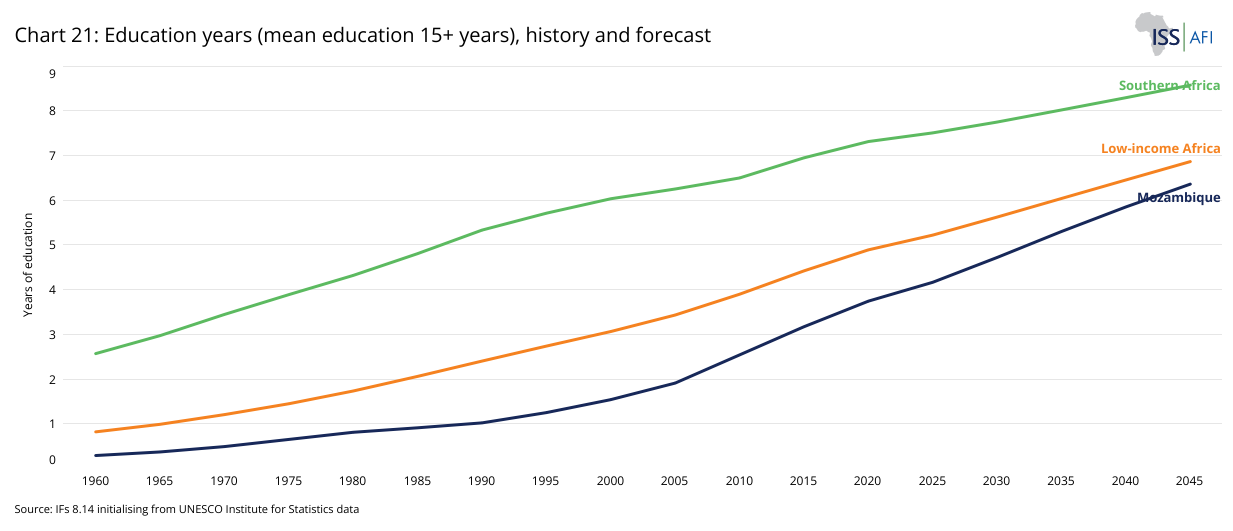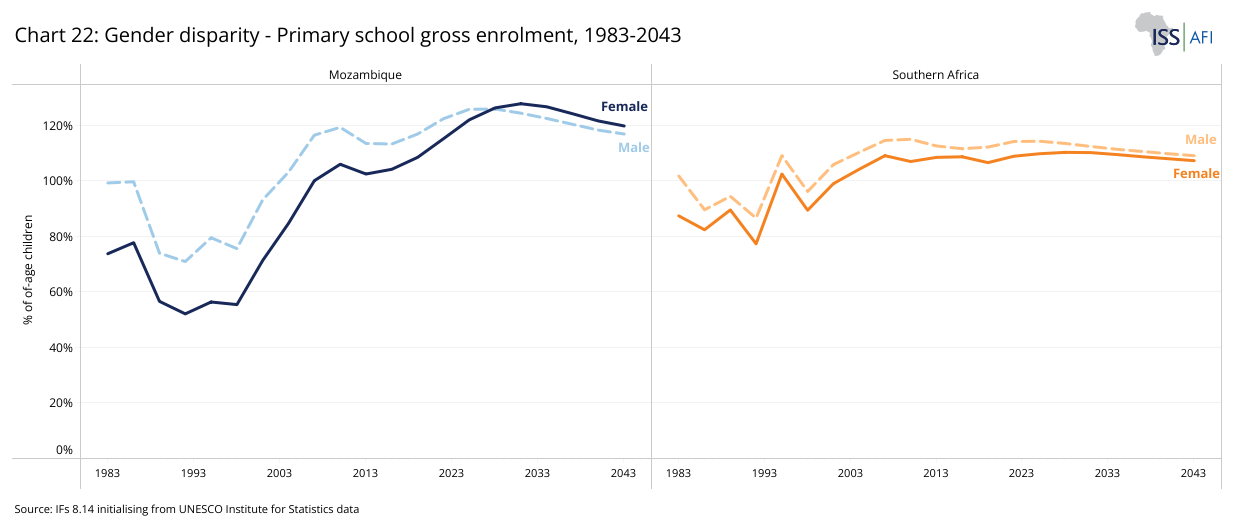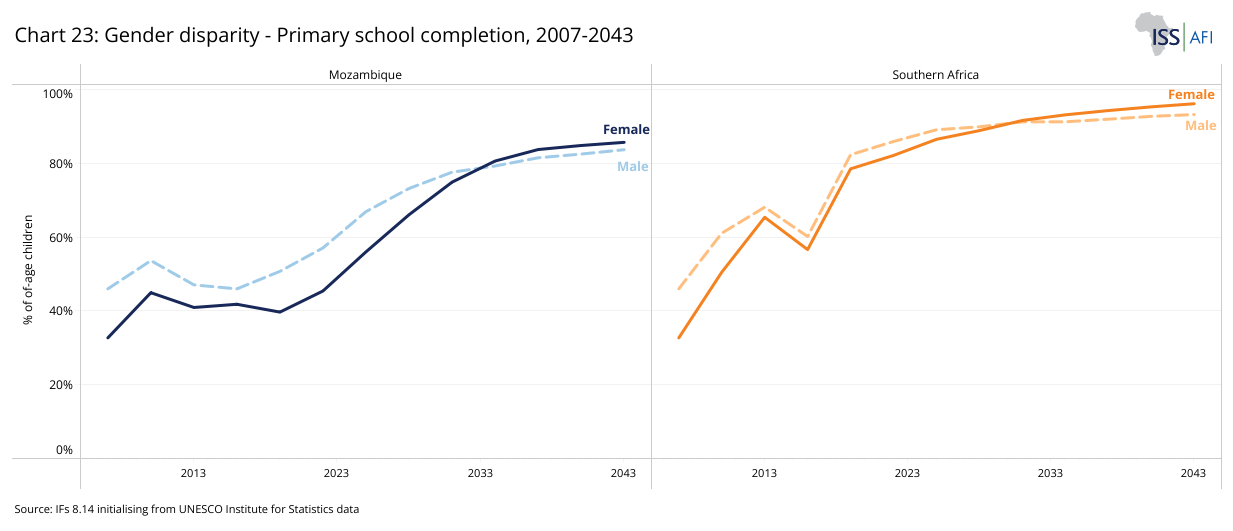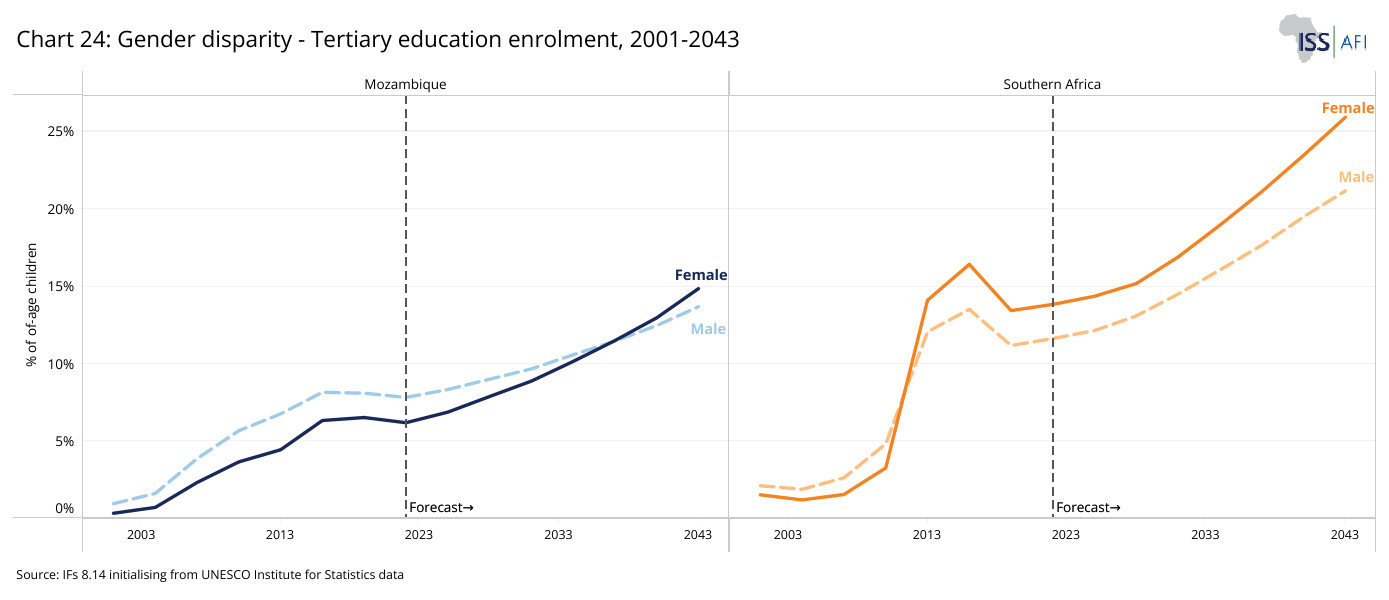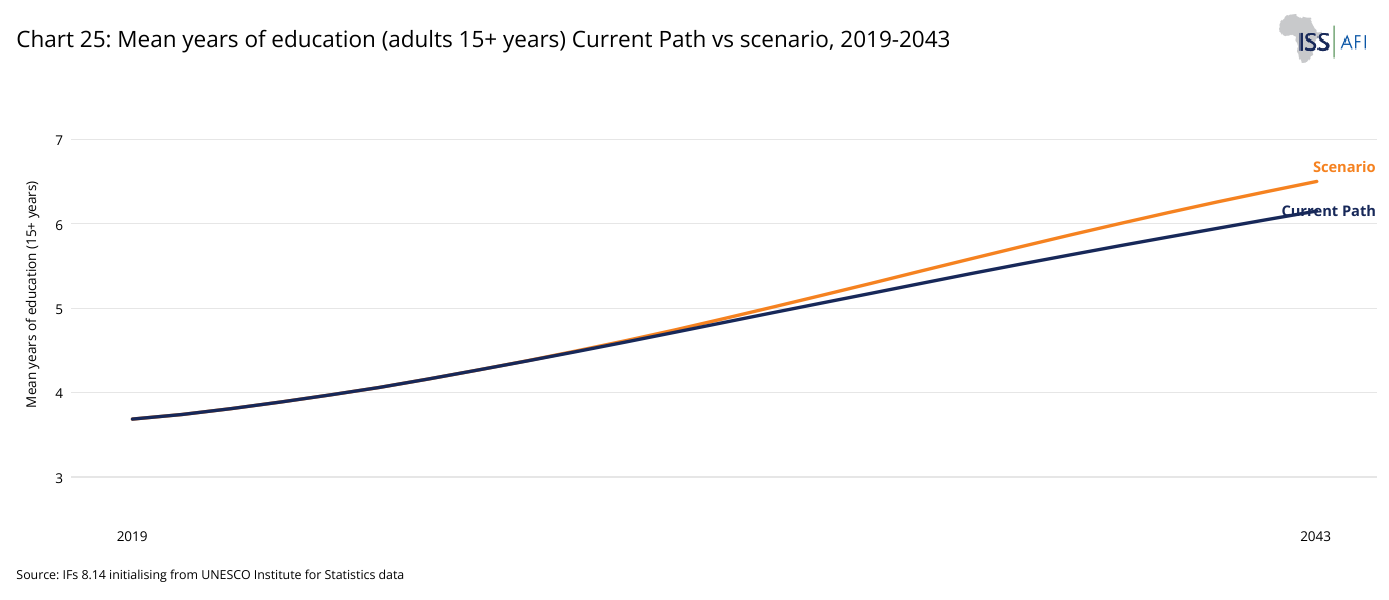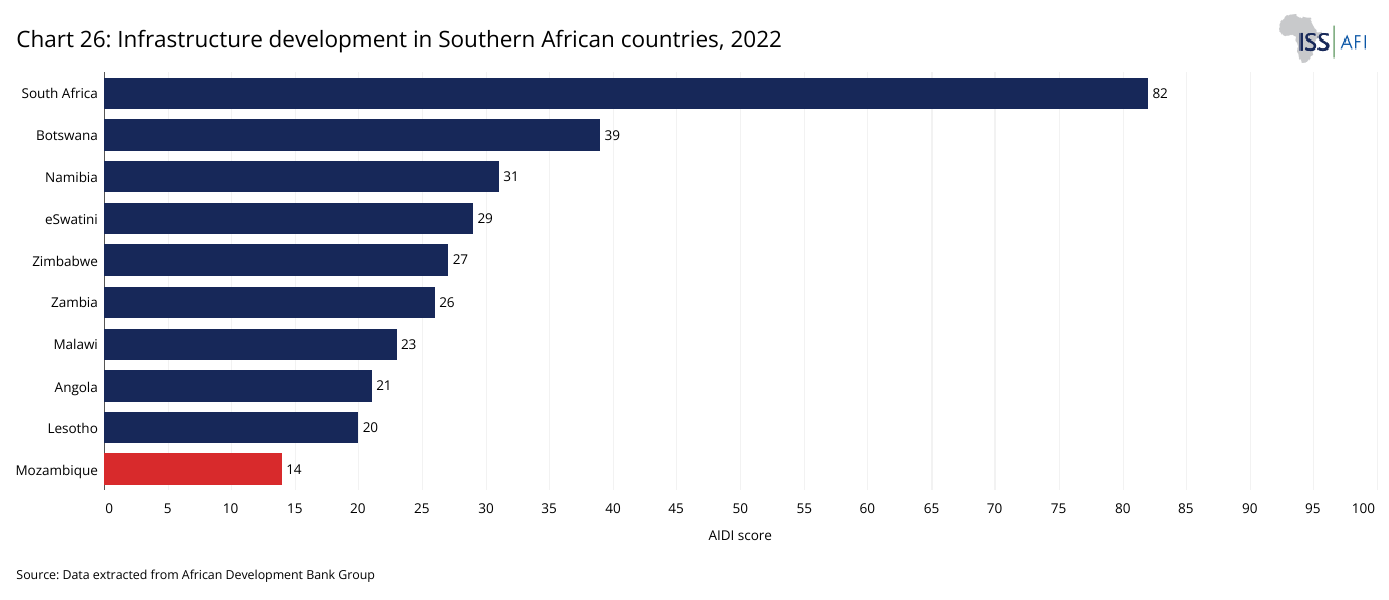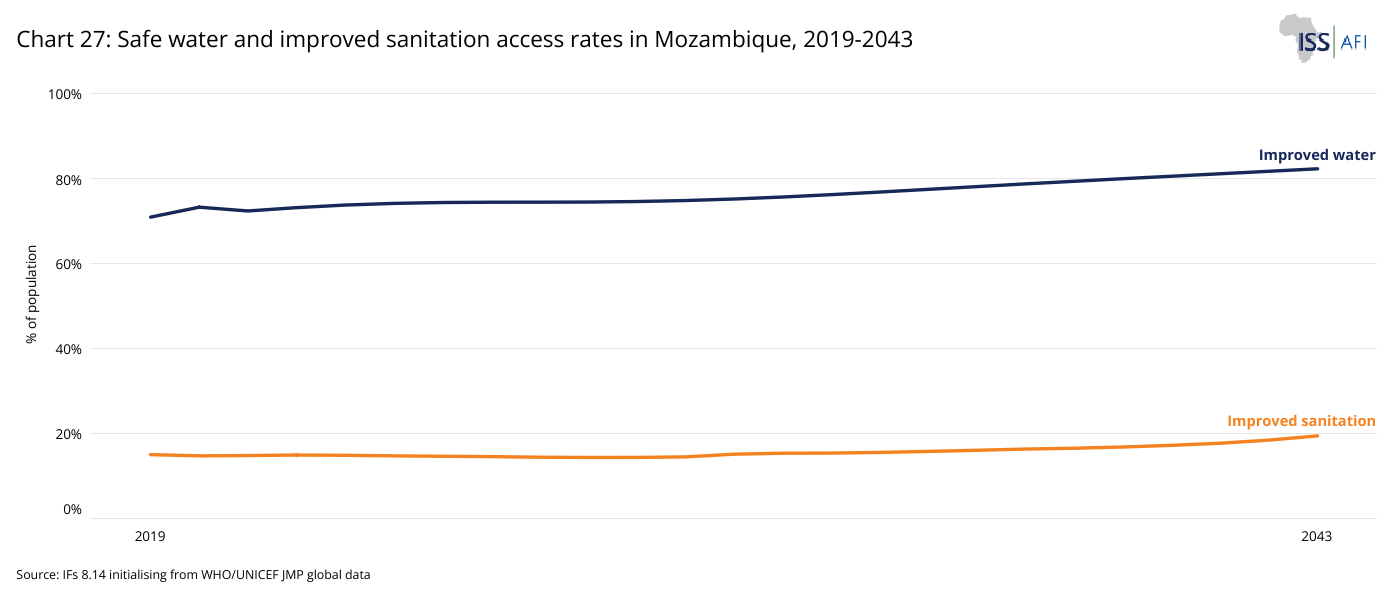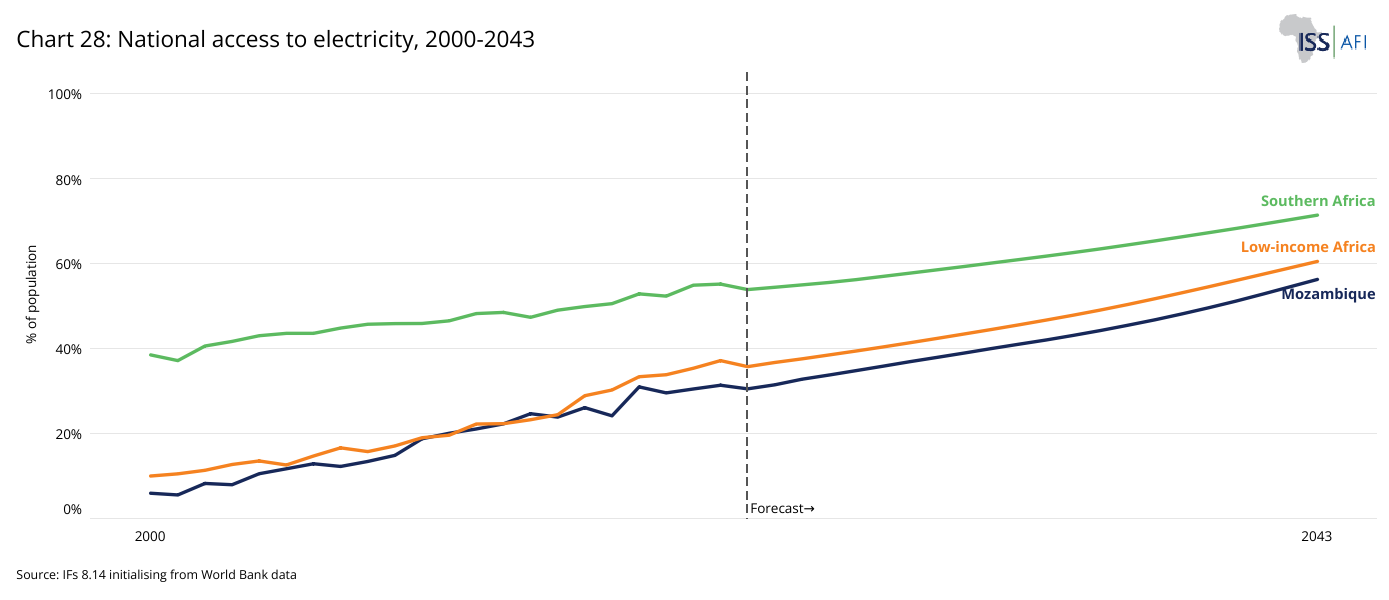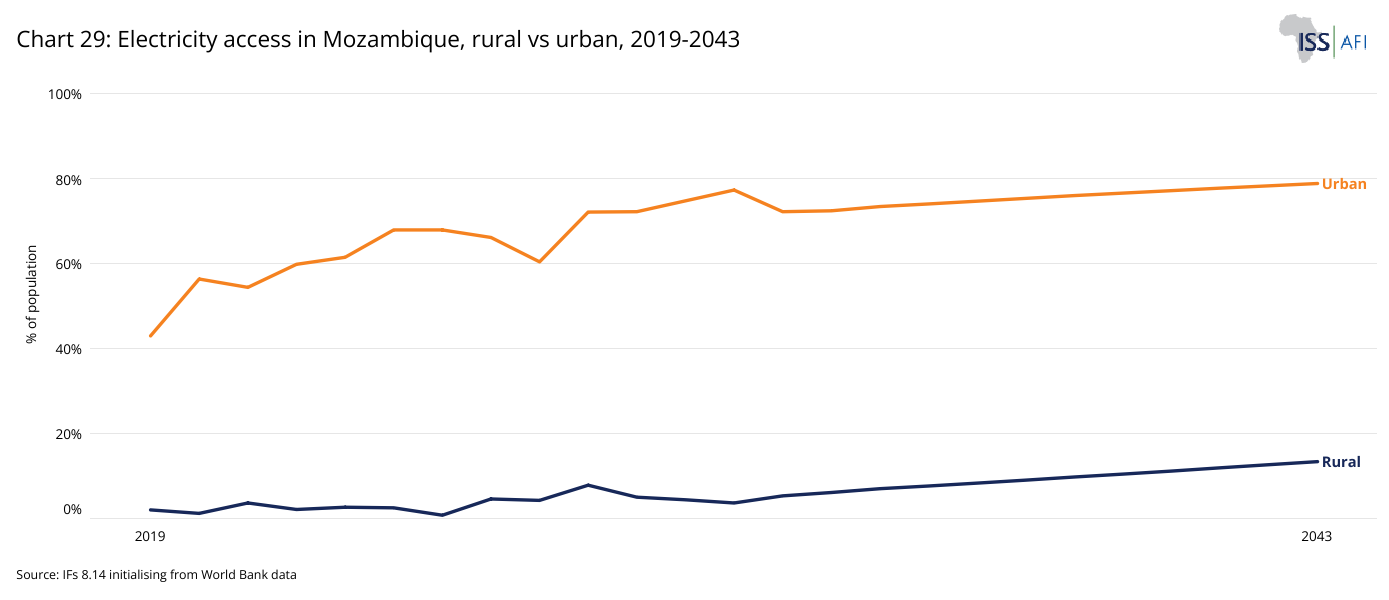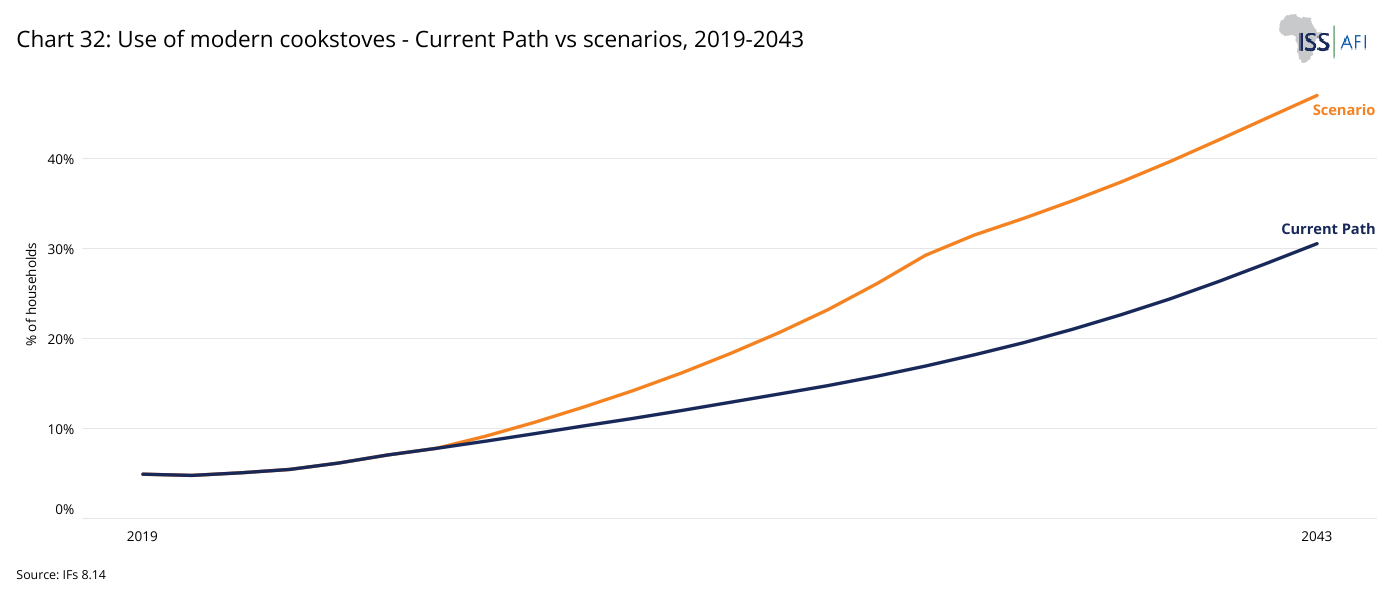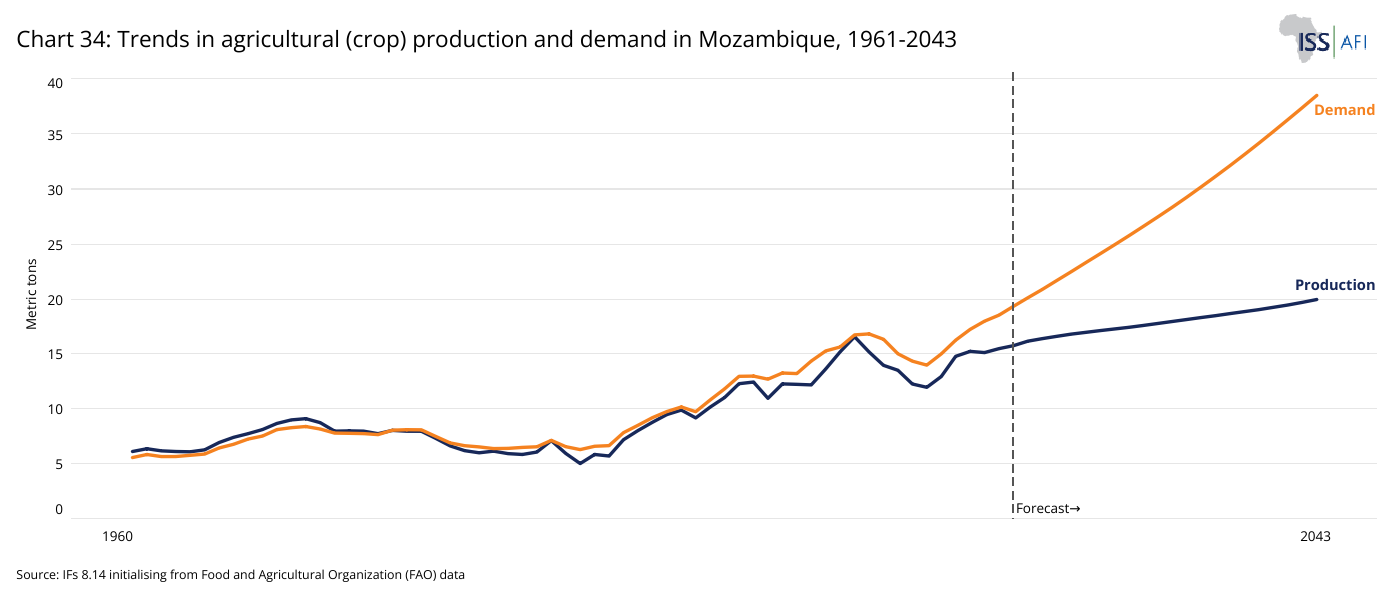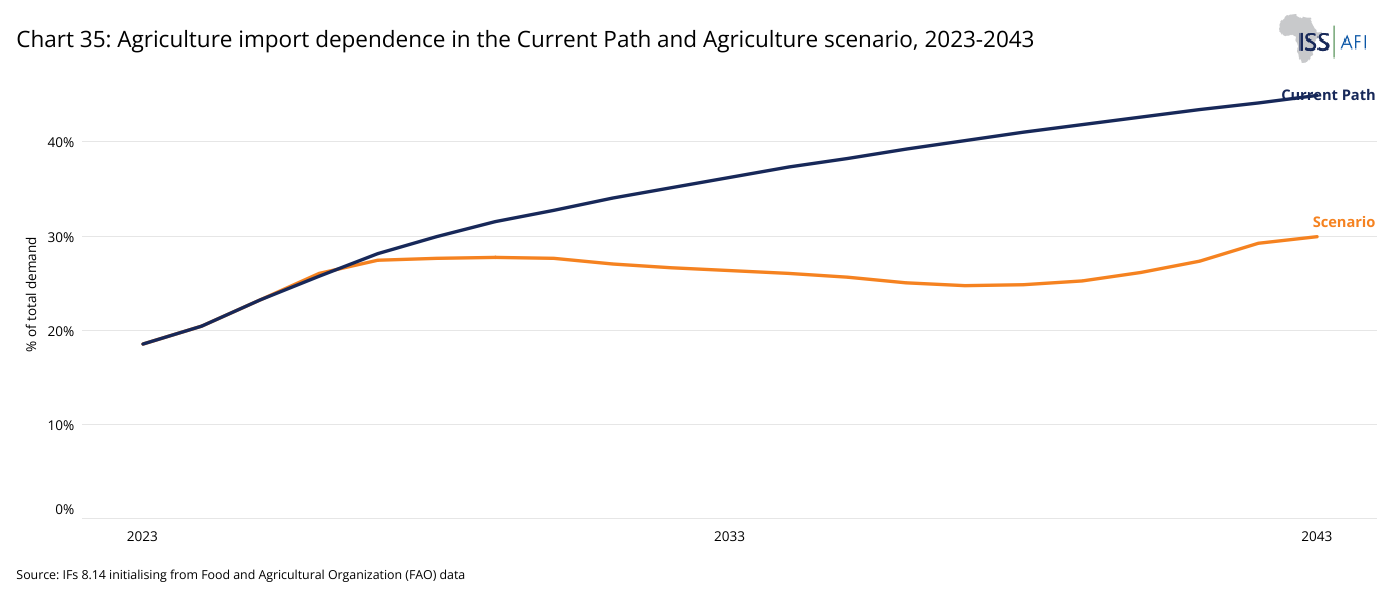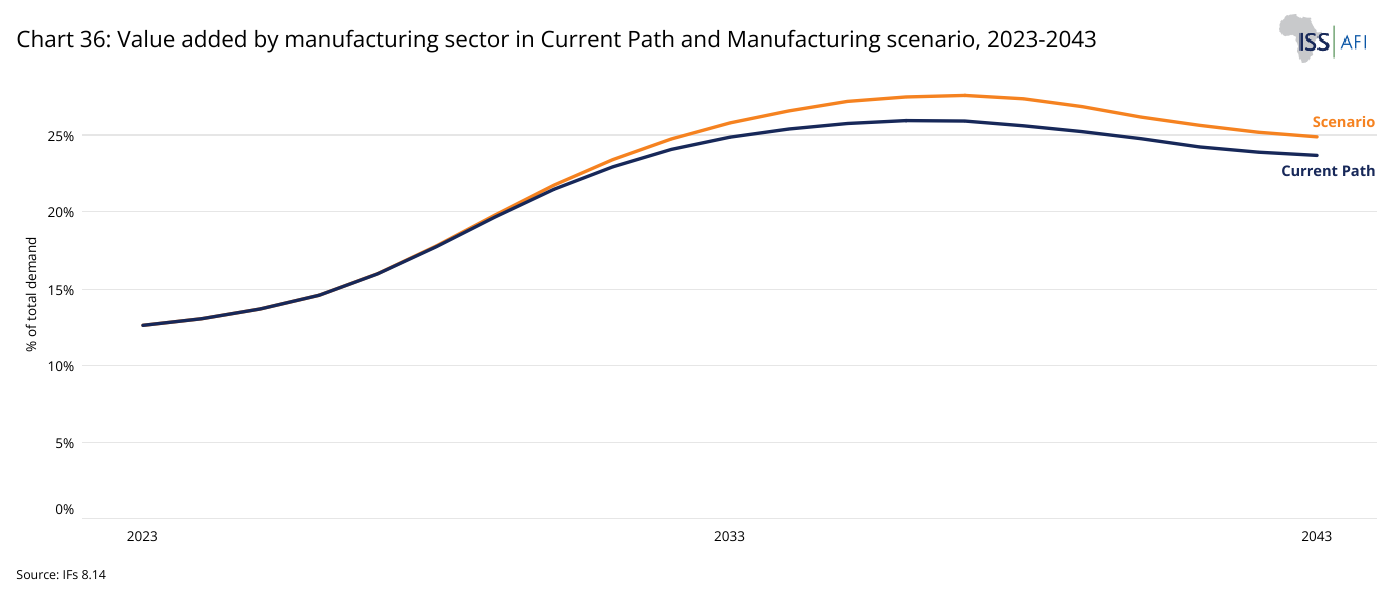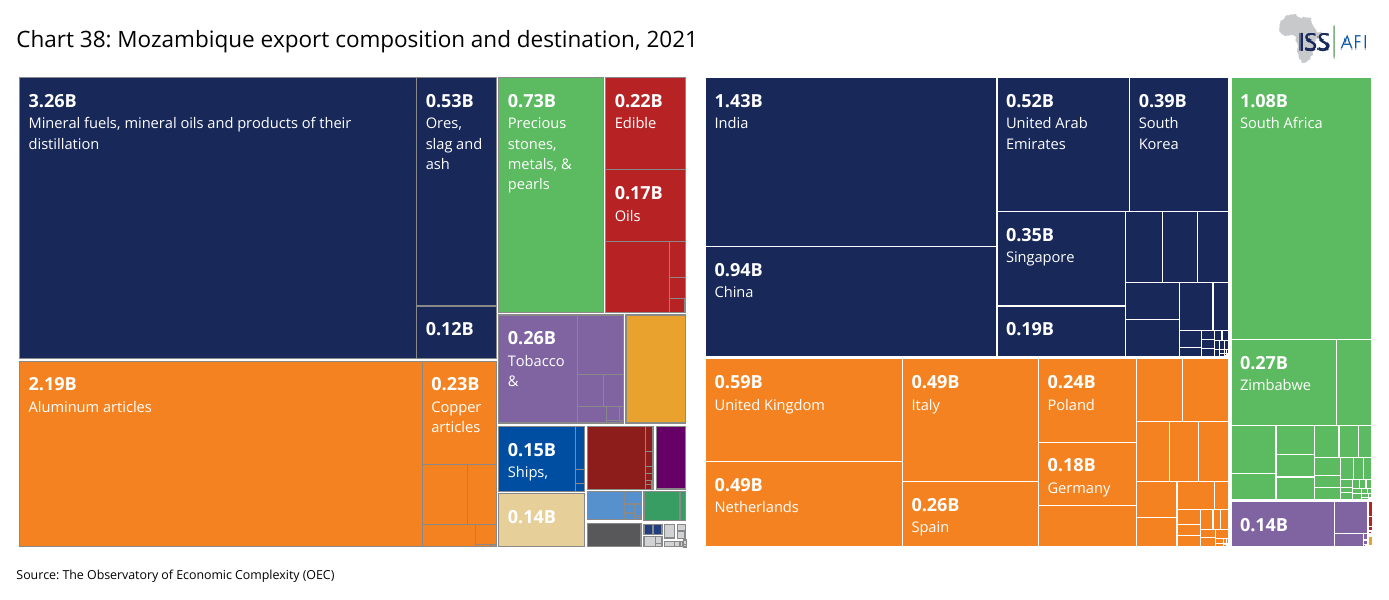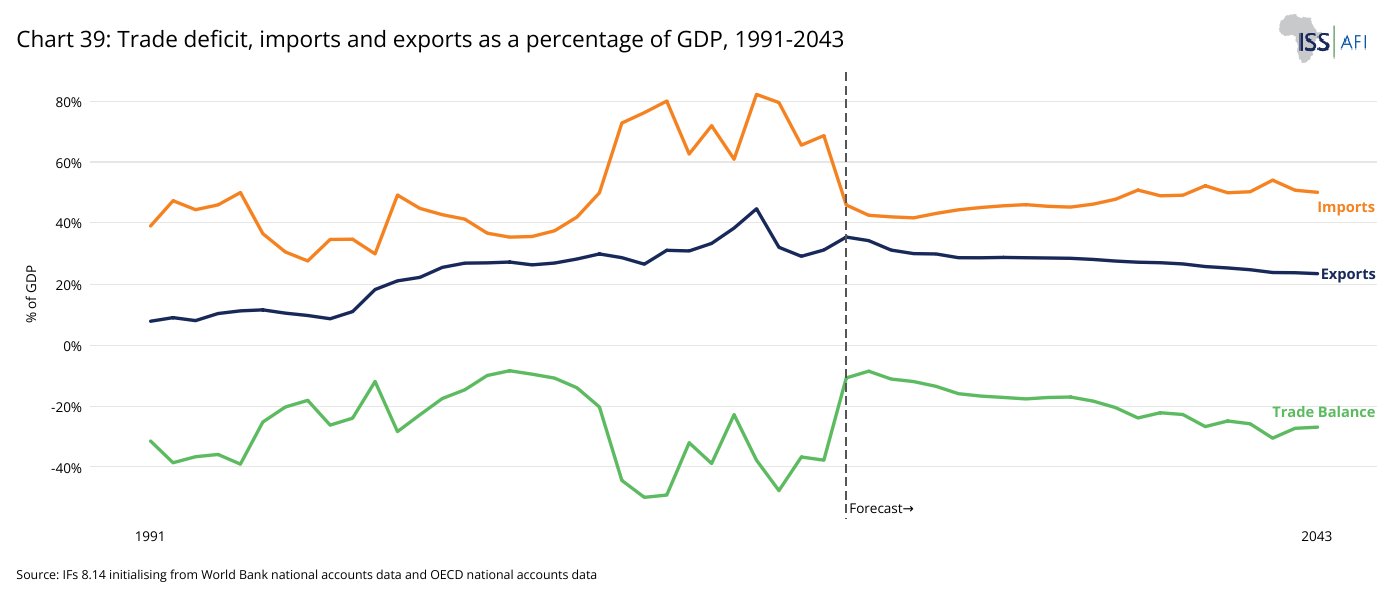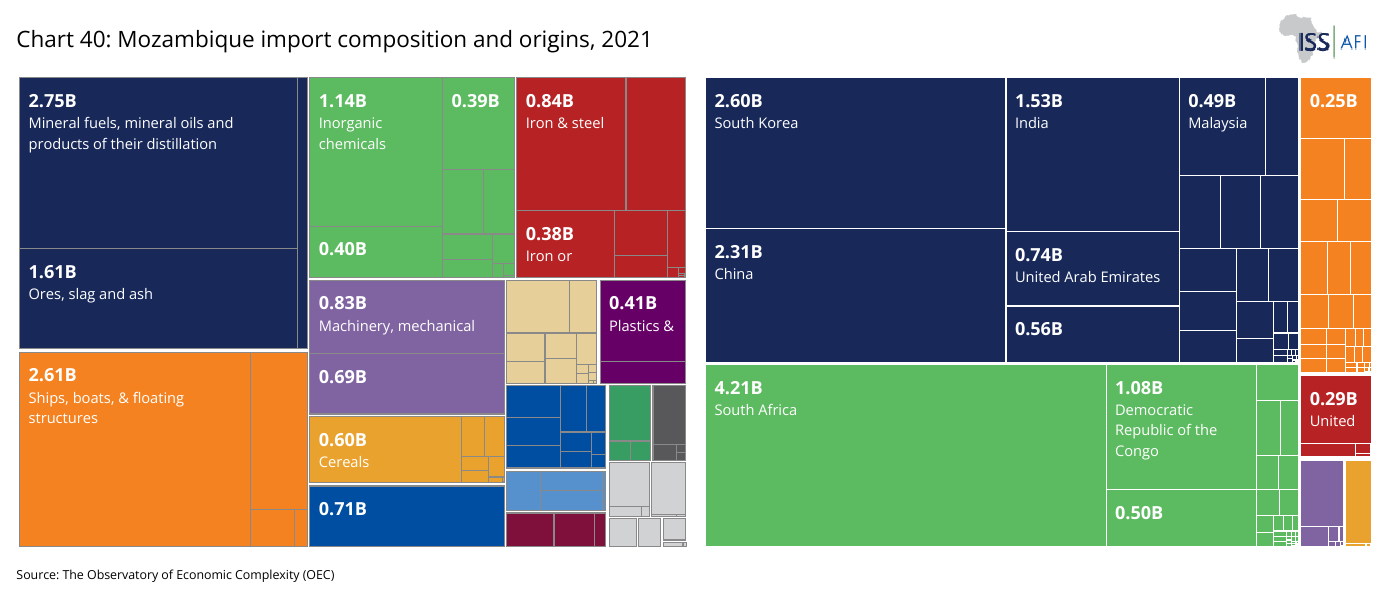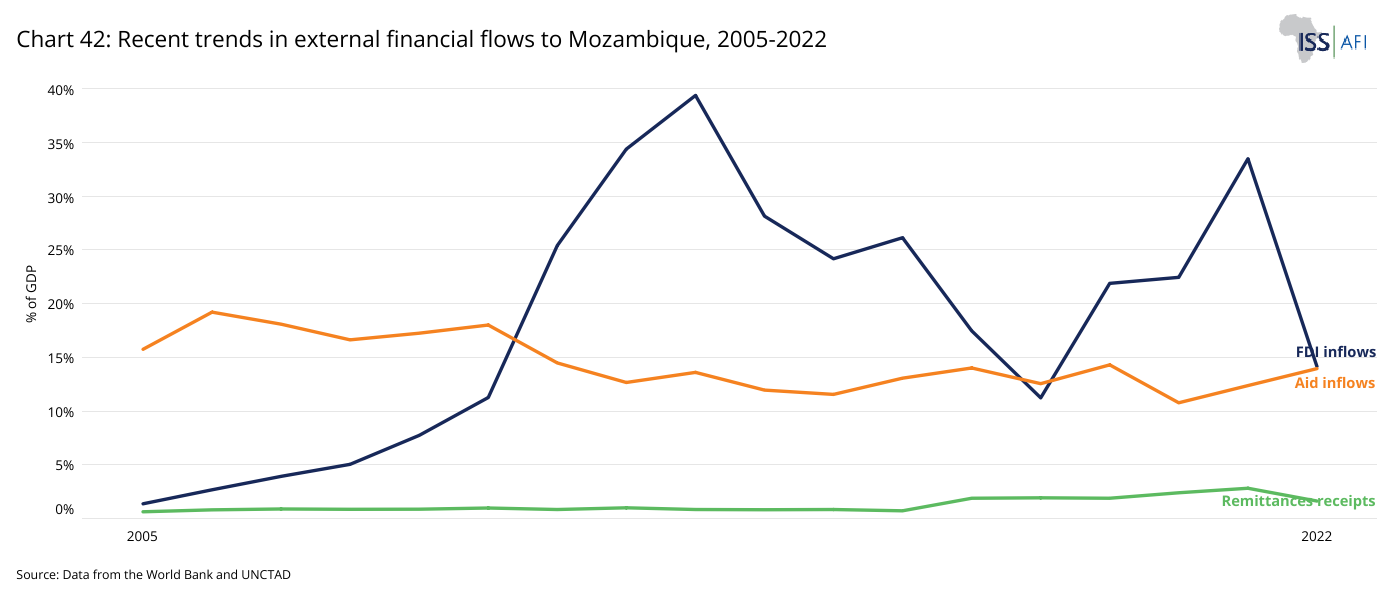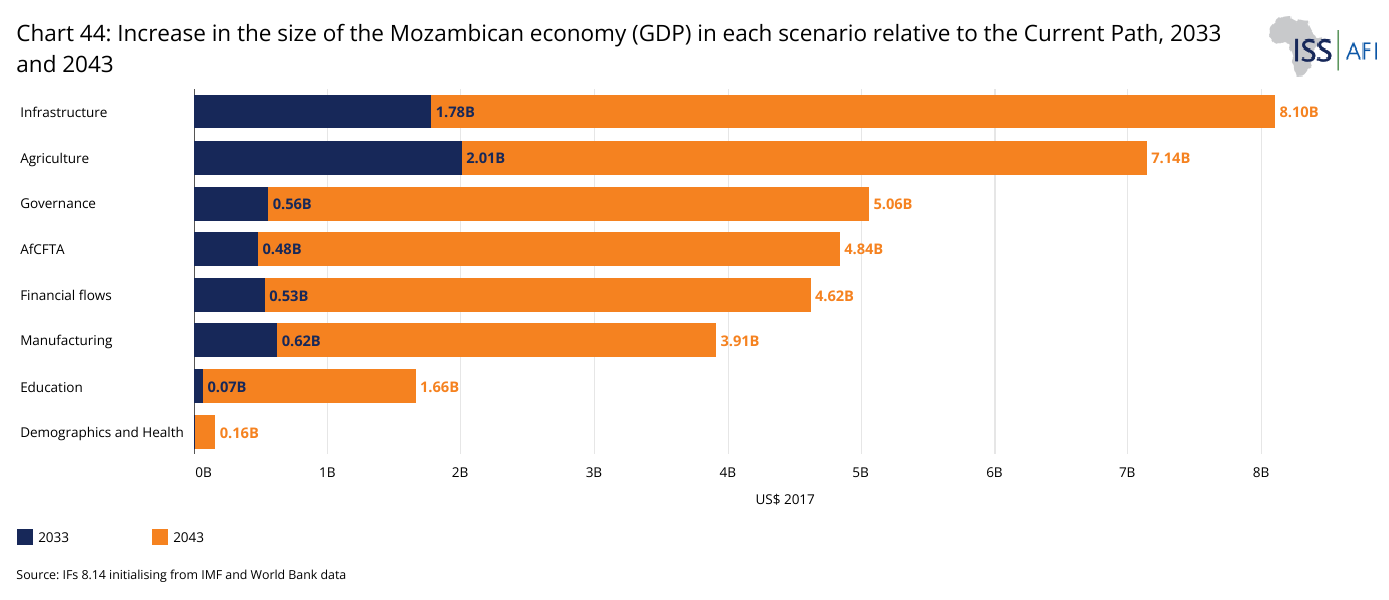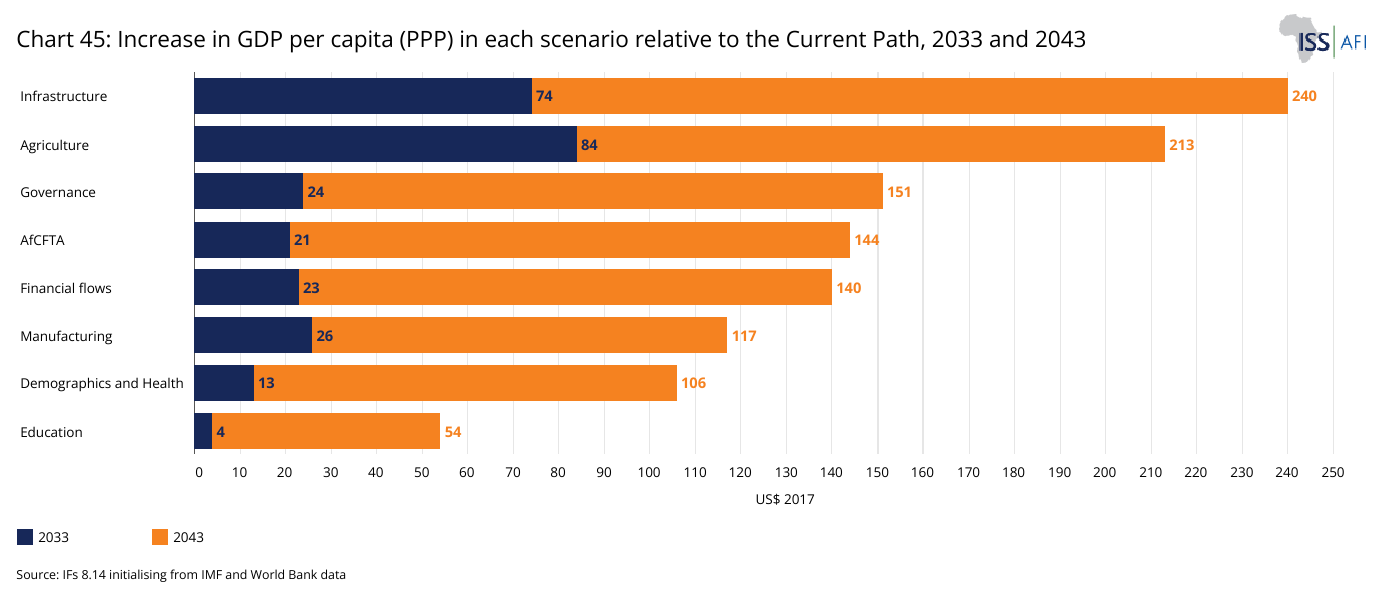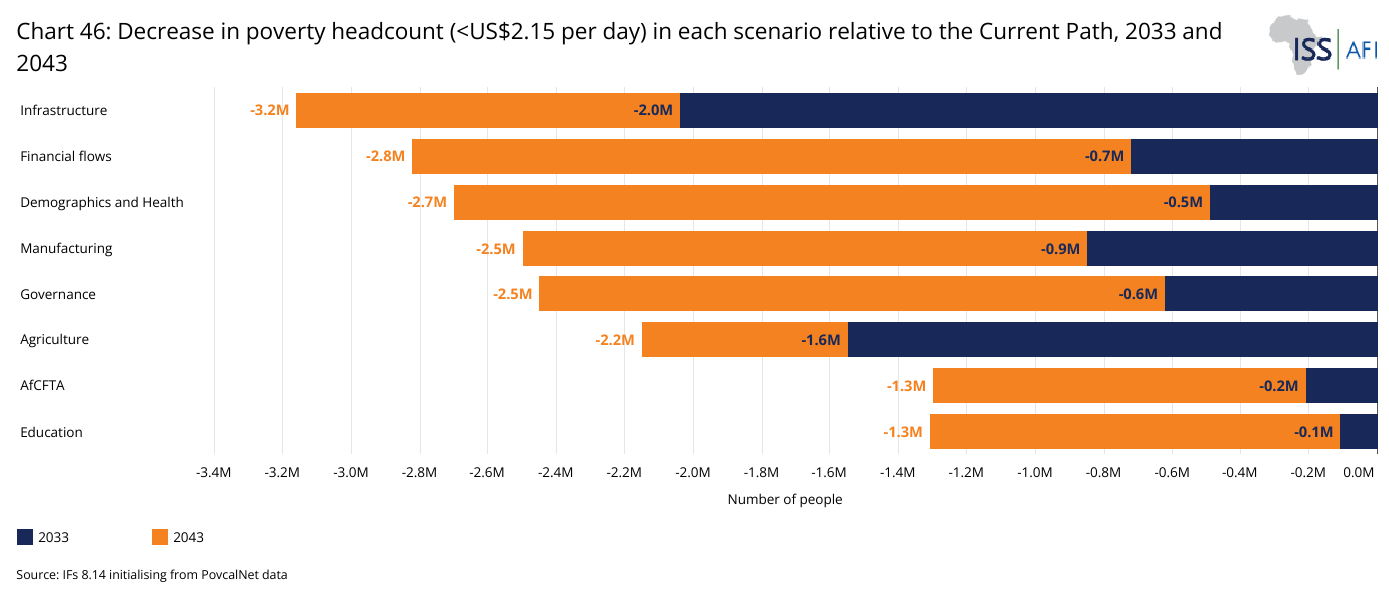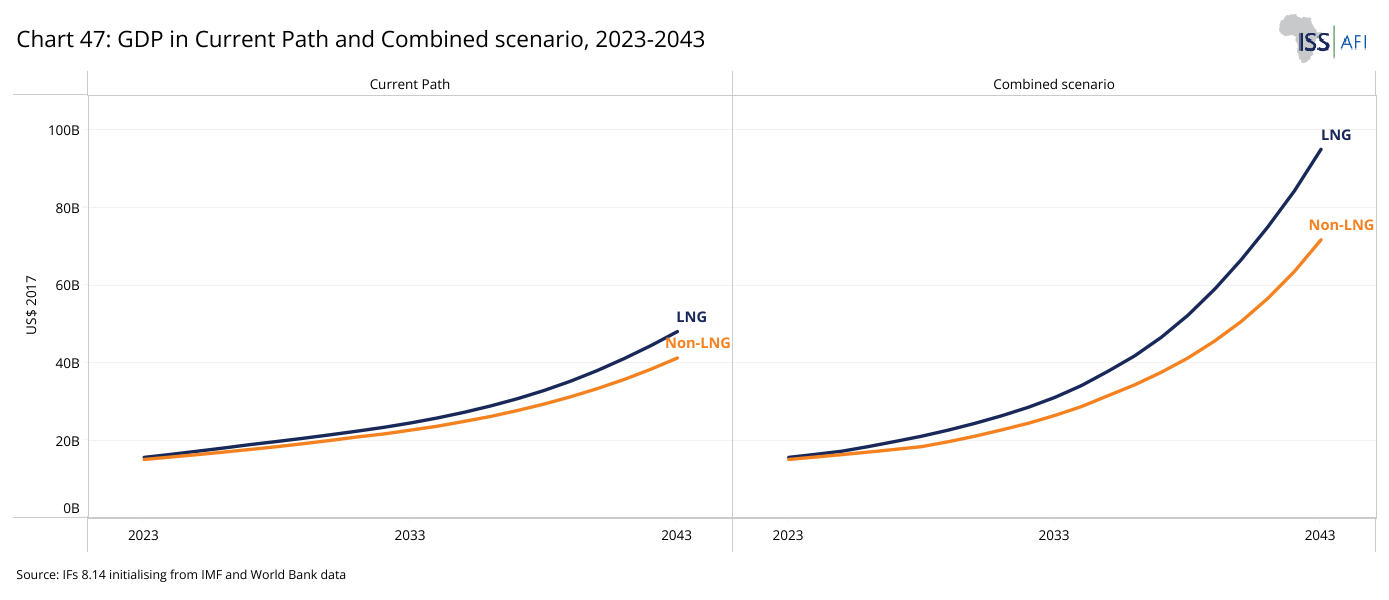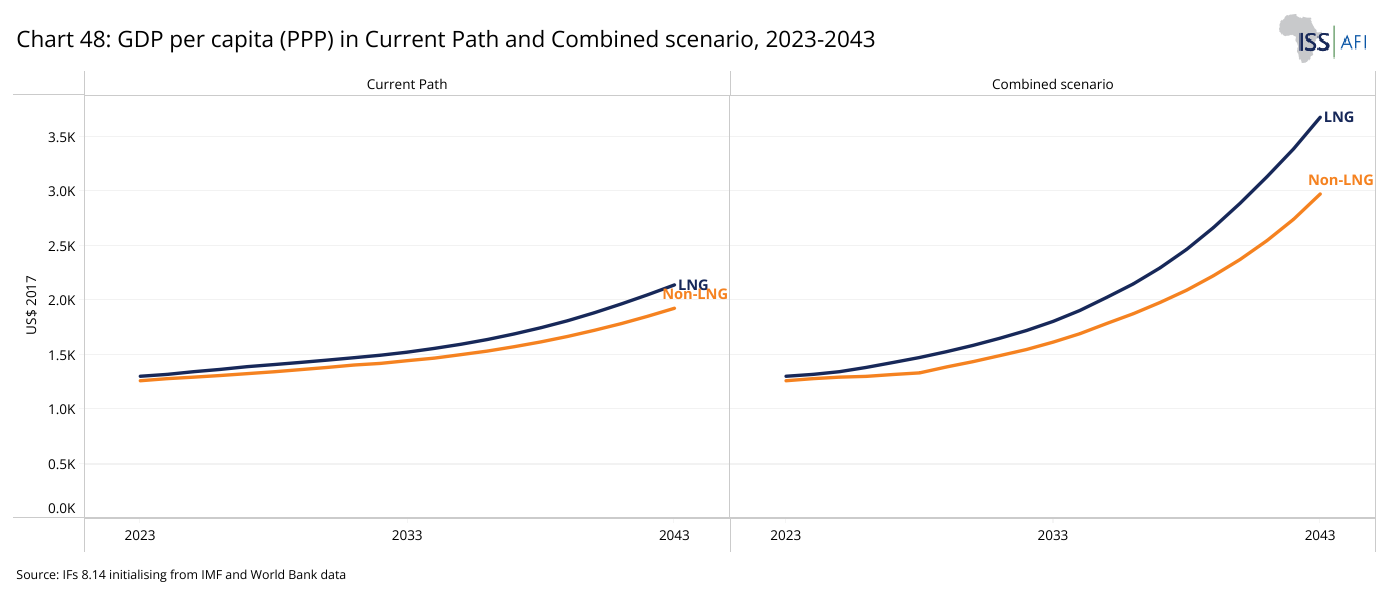Unveiling Potential: Boosting Inclusive Growth and Development in Mozambique
Summary
Mozambique, situated in Southern Africa and bordered by six countries, is rich in mineral reserves, arable land, and a coastline. After achieving independence in 1975 and ending a 15-year civil war in 1992, Mozambique began to experience socio-economic progress. Between 1993 and 2015, it was one of Africa’s fastest-growing economies, with an average annual growth rate of about 8%. This growth was driven by factors such as political and macroeconomic stability, a rebound in post-war economic activity, increased Foreign Direct Investment (FDI) in extractive industries, and post-war reconstruction efforts. This rapid economic growth improved life expectancy, reduced mortality rates, and expanded access to education, water, and electricity.
However, these high growth rates were not inclusive enough and not accompanied by a structural transformation of the economy. The country remains one of the poorest globally, with a GDP per capita of about US$450 in 2023 and high levels of poverty and inequality. Post-2015 growth slowed to an average of about 3% due to various challenges including the "hidden debt" scandal, insurgencies, natural disasters and the COVID-19 pandemic. The Government of Mozambique faces the urgent task of achieving sustainable and inclusive growth, with hopes pinned on gas megaprojects. However, past experiences in Africa indicate that natural resource extraction does not always lead to desired outcomes. Therefore, achieving meaningful growth requires strategic leadership and investment in sustainable development.
The Mozambique National Development Strategy 2023-2043 seeks to address these challenges through economic diversification and infrastructure improvement. The discovery of 150 trillion cubic feet of natural gas in 2010 holds the potential for an economic boost, yet revenue projections are uncertain due to volatile markets. Additionally, the country’s informal economy, with 96% of the workforce in 2021, hinders development and reduces government revenue. By 2022, 71% of the population lived in extreme poverty, affecting 23 million people.
An analysis using the International Futures forecasting tool suggests that Mozambique is likely to miss most of its development targets by 2043 under current trajectories due to governance issues, infrastructure bottlenecks, low agricultural productivity and limited economic diversification. The sectoral scenario analysis, which models ambitious but realistic policy interventions across eight sectors (agriculture, education, governance, infrastructure, health and demographics, financial flows, manufacturing and trade), shows that the Infrastructure scenario will have the most significant impact on Mozambique’s GDP growth by 2043, followed by the Agriculture, Governance and Free Trade (AfCFTA) scenarios. In reducing extreme poverty, it will be the Infrastructure scenario followed by the Financial Flows, Manufacturing and Governance scenarios. In the short-to-medium term (i.e., up to 2035), Agriculture has the biggest impact on GDP. Infrastructure development and the Agriculture scenario will have the most significant impact on poverty reduction compared to other scenarios.
The findings underscore that no single scenario is a panacea for achieving meaningful inclusive growth by 2043. All scenarios boost GDP, with Infrastructure having the most significant impact. A comprehensive effort to improve outcomes across all these sectors will help set the country on a track toward inclusive growth and development. The integrated development push across all the above sectors (the Combined scenario) offers the most substantial improvements. It will result in an economy (GDP) that is US$47 billion larger than the Current Path forecast in 2043. GDP per capita (purchasing power parity) will be US$1 536 larger than what it would be on the Current Path in 2043. The poverty rate at US$2.15 is 22.4% in 2043 instead of 44.9% on the Current Path in the same year. This Combined scenario demands strong political commitment and wise investment of natural gas revenues for sustainable, inclusive growth.
The study recommends ambitious yet feasible policy interventions across all sectors and highlights the importance of mitigating natural disaster risks and climate change impacts. Overall, the study emphasises the need for comprehensive, strategic leadership and investment in sustainable development to achieve meaningful growth. By addressing governance issues, enhancing infrastructure, improving agricultural productivity and diversifying the economy, Mozambique can set a path towards inclusive and sustainable development.
All charts for Unveiling Potential: Boosting Inclusive Growth and Development in Mozambique
- Chart 1: Mozambique, political map
- Chart 2: Visual representation of International Futures (IFs) modelling platform
- Chart 3: Mozambique liquefied natural gas map
- Chart 4: Trends in GDP per capita (PPP): Mozambique and other groups, 1960-2043
- Chart 5: Informal Economy size in the Current Path, 2022–2043
- Chart 6: Monetary poverty in Mozambique (<US$2.15 per day and person), 1996–2043
- Chart 7: Income inequality in Mozambique, 1996-2043
- Chart 8: Governance performance for Mozambique, 2023 and 2043
- Chart 9: Composite governance index in Current Path and Governance scenario, 2023-2043
- Chart 10: Population growth rates in Mozambique, 2023-2043
- Chart 11: Fertility trajectory in Mozambique, 1960-2043
- Chart 12: Population structure in Mozambique, 1960-2043
- Chart 13: Percentage of population living in urban and rural areas in Mozambique, 1960-2043
- Chart 14: Government expenditure on health as % of total government expenditure, 2000-2021
- Chart 15: Maternal mortality, Mozambique, and its peers, history and forecast, 2000-2043
- Chart 16: Life expectancy and infant mortality, 1960-2043
- Chart 17: Death rates by cohort, Mozambique, 2022
- Chart 18: Mortality distribution by main International Classification of Diseases (ICD) categories, 1990-2043
- Chart 19: Demographic dividend in Current Path and Demographics and Health scenario, 2019–2043
- Chart 20: Education flow rates, Mozambique, 2022
- Chart 21: Education years (mean education 15+ years), history and forecast
- Chart 22: Gender disparity - Primary school gross enrolment, 1983-2043
- Chart 23: Gender disparity - Primary school completion, 2007-2043
- Chart 24: Gender disparity - Tertiary education enrolment, 2001-2043
- Chart 25: Mean years of education (adults 15+ years) Current Path vs scenario, 2019-2043
- Chart 26: Infrastructure development in Southern African countries, 2022
- Chart 27: Safe water and improved sanitation access rates in Mozambique, 2019–2043
- Chart 28: National access to electricity, 2000-2043
- Chart 29: Electricity access in Mozambique, rural vs urban, 2019-2043
- Chart 30: Paved roads as % of the total road network, 2015-2043
- Chart 31: Internet and broadband penetration in Mozambique, 2019-2043
- Chart 32: Use of modern cookstoves - Current Path vs scenario, 2019-2043
- Chart 33: Average crop yields per hectare (metric tons), Mozambique, 1965-2043
- Chart 34: Trends in agricultural (crop) production and demand in Mozambique, 1961-2043
- Chart 35: Agriculture import dependence in the Current Path and Agriculture scenario, 2023–2043
- Chart 36: Value added by manufacturing sector in Current Path and Manufacturing scenario, 2023-2043
- Chart 37: Mozambique export, imports and trade balance, 1991-2043
- Chart 38: Mozambique export composition and destination, 2021
- Chart 39: Trade deficit, imports and exports as a percentage of GDP, 1991-2043
- Chart 40: Mozambique import composition and origins, 2021
- Chart 41: Trade balance in Current Path and AfCFTA scenario, 2023-2043
- Chart 42: Recent trends in external financial flows to Mozambique, 2005–2022
- Chart 43: Government revenue in Current Path and Financial Flows scenario, 2023-2043
- Chart 44: Increase in the size of the Mozambican economy (GDP) in each scenario relative to the Current Path, 2033 and 2043
- Chart 45: Increase in GDP per capita (PPP) in each scenario relative to the Current Path, 2033 and 2043
- Chart 46: Decrease in poverty headcount (<US$2.15 per day) in each scenario relative to the Current Path, 2033 and 2043
- Chart 47: GDP in Current Path and Combined scenario, 2023-2043
- Chart 48: GDP per capita (PPP) in Current Path and Combined scenario, 2023-2043
- Chart 49: Extreme Poverty (<US$2.15 per day) in Current Path and Combined scenario, 2023-2043
Located in Southern Africa, Mozambique is nestled between Tanzania, Malawi, Zambia, Zimbabwe, South Africa and Eswatini. It is one of the 22 low-income countries in Africa and had an estimated population of about 33 million in 2023. The country has considerable mineral reserves, vast arable land and an extensive coastline along which flows the warm Mozambique current that feeds its rich aquatic life.
Mozambique achieved independence in 1975, but only after the end of a 15-year civil war in 1992 did it begin to experience socio-economic progress. Between 1993 and 2015, Mozambique was one of Africa’s fastest-growing economies, with an average annual growth rate of about 8% as the fruits of several factors such as political and macroeconomic stability, rebound in post-war economic activity, more Foreign Direct Investment (FDI) into the extractive industries and post-war reconstruction.[1] During this period, important gains have been achieved, such as reduced maternal and child mortality rates, increased access to basic education services for girls and boys, water and electricity. Around one-third of the population now has access to electricity, compared to barely 4% in 1998, and over the last decade, new HIV cases have fallen by 34% and AIDS-related deaths by 27%.[2] The combination of these results is reflected in the improvement of the life expectancy of Mozambicans from 51 years in 1992 to about 61 in 2021.
Yet, the country faces significant development challenges. It is among the poorest countries in the world, with a GDP per capita of US$447 (market exchange rate) or US$1 243 (purchasing power parity (PPP)) in 2022, only ahead of Somalia, Central African Republic, Burundi and South Sudan in Africa. According to the latest estimates, by the end of 2022, 71% of Mozambicans lived below the international poverty line of US$2.15 per day[3] and the country is among the most unequal in sub-Saharan Africa. In its 2021/2022 report, the United Nations Development Programme (UNDP) classified Mozambique as a country with low human development, with a score of 0.446 (out of 1) on the Human Development Index (HDI). Mozambique ranks 185th out of 191 countries, far below its neighbours.
The post-2015 growth has been slow (averaging 3% between 2016 and 2022) amid the ‘‘hidden debt’’ scandal which coincided with a series of shocks, including an insurgency in Northern Mozambique, tropical cyclones and the Covid-19 pandemic, while unemployment, poverty and inequality have increased.
The previous decade of high growth rates was not accompanied by structural transformation and industrialisation of the economy, which continues to rely heavily on the extractive sector, with limited linkages with the rest of the economic sectors, and a low-productivity agriculture sector, which is extremely vulnerable to weather shocks and climate change. Factors such as inadequate infrastructure, ineffective policy implementation, corruption and a poor business environment constrain economic diversification and the quality of growth.[5]
The government is now faced with a pressing question of how to achieve long-term sustainable and inclusive growth to ensure steady reductions in income inequality and extreme poverty. Expectations from the gas megaprojects in its northern provinces to transform the country’s future are high. However, experience elsewhere in Africa has shown that natural resource extraction has rarely lived up to its promise, often doing more harm than good. Translating growth and revenue from natural resource extraction into improved and inclusive development outcomes requires visionary leadership and developmentally oriented governing elites to carefully manage and invest the revenue in sustainable economic and human development.
The Mozambique National Development Strategy or Estratégia Nacional De Desenvolvimento (ENDE) 2023-2043 guides the country's development process, aiming to achieve a long-term vision for the country. Its objectives include improving the country's infrastructure, increasing productivity and competitiveness, promoting economic diversification, promoting access to basic services, promoting social inclusion, strengthening governance and transparency, as well as environmental sustainability to increase the country's productive capacity, the population's living conditions, and reduce social and regional inequalities. To achieve these objectives, the ENDE is structured around five main pillars: (i) Structural Transformation of the Economy; (ii) Social and Demographic Transformation; (iii) Infrastructures; (iv) Governance; and (v) Environment and circular economy. Each pillar has strategic objectives, result indicators and targets for the period 2023-2043.
This report complements the Mozambique Growth Diagnostic Study conducted by the London School of Economics (LSE) Growth Diagnostic Lab which analyses the country’s past and current socio-economic situation as well as the key binding constraints to inclusive growth. We take a forward-looking approach to analyse the likely future of Mozambique along the Current Path forecast (or business-as-usual scenario) and answer the following questions: What are the trends that have shaped modern Mozambique, and how do they compare with trends for other countries at similar levels of development? Given the current policies, environmental conditions and future revenues from megaprojects in gas, what would the situation be in 2043, in line with targets in Mozambique’s National Development Strategy 2023-2043? This report explores a series of sectoral scenarios to emulate their comparative and cumulative effect towards sustained, inclusive growth and development in Mozambique.
[1] The World Bank, Poverty Reduction Setback in Times of Compounding Shocks: Mozambique Poverty Assessment, June 2023.
[2] UK–Mozambique development partnership summary, Policy paper, July 2023
[3] Salome Ecker et al.(2023), the impact of the cost-of-living crisis on poverty in Mozambique and possible policy responses, United Nations Development Programme.
[5] Neil Balchin et al (2017). Economic transformation and job creation in Mozambique, Synthesis paper.
The foresight analysis in this report relies on the International Futures (IFs) modelling tool, developed by the Frederick S. Pardee Center for International Futures at the University of Denver, United States. IFs is a tool for thinking about long-term, country-specific, regional and global developments. The model integrates forecasts across many sub-models, including demographics, economics, health, education, infrastructure, agriculture, energy, technology, governance, international politics, socio-political issues and the environment. These sub-models are dynamic and integrated, allowing for simulations that demonstrate how changes in one system can lead to changes across all other systems. The scenario analysis capabilities of IFs allow users to explore the potential impact of simulated policy interventions or to frame long-term uncertainty within and across development systems.[x]
IFs models development for 189 countries and their interaction, including 55 countries in Africa that can be combined to analyse and forecast the future of any group of countries. It blends different modelling techniques to form a series of relationships based on academic literature to generate its forecasts. IFs uses historical data from 1960 (where available) to identify trends and to produce a 'Current Path forecast' scenario from 2019 (the current base year). The Current Path is a dynamic scenario representing a continuation of current policy choices and technological advancements and assumes no significant shocks or catastrophes. It moves beyond a linear extrapolation of past and current trends by leveraging our available knowledge about how systems interact to produce a dynamic forecast. Currently, IFs is one of the few global modelling platforms capable of projecting Sustainable Development Goals (SDGs) achievement across many of the SDGs at the country level,[1] and has been widely used in the analysis of African development.[2]
The data series within IFs come from a range of well-known sources such as the World Bank, the International Monetary Fund (IMF), the World Health Organization (WHO) and various United Nations (UN) bodies like the Food and Agriculture Organization (FAO) and United Nations Population Fund (UNPF), etc. These organisations collect and standardise data which is essential for cross-country comparisons.
The project uses an additional project data file with updated key data series as supplied by the various Mozambican authorities. The data series that was adjusted for this study is presented in an annexure to this report.
This report uses Africa's low-income countries as a benchmark for gauging Mozambique's historical and future progress. Where appropriate, Mozambique is compared to regional peers.
For this study, we adjusted the Current Path to account for the gas project, given its potential impact on development prospects based on research and consultations with gas experts, economists and government officials during a consultation meeting in Maputo.
In 2010, Mozambique made significant discoveries of natural gas totalling approximately 150 trillion cubic feet (Tcf) in the adjacent blocks of Area 1 and Area 4 within the offshore Rovuma Basin, situated off the northern Cabo Delgado province. This positioned Mozambique as Africa's third-largest holder of natural gas reserves, following Nigeria and Algeria.[1]
TotalEnergies and its consortium partners are set to exploit the liquefied natural gas (LNG) field in Area 1, known as the Offshore Area 1 Golfinho/Atum gas field, located in Mozambique’s deepwater Rovuma Basin. The investment for this endeavour is estimated at US$20 billion. Area 4 comprises two projects: the onshore Area 4 Mamba field and the offshore Area 4 Coral South field, controlled by a consortium primarily led by ExxonMobil and ENI, with an estimated investment of US$30 billion (combining onshore and offshore components).[2] Notably, the final investment decision for the Area 4 Coral South field (offshore) is pending, with experts predicting it will be between 2025 and 2026.
Given the significant delays in gas exploitation, the timeline for gas production and the estimated associated revenue is highly uncertain. Revenue projections vary significantly depending on assumptions, especially the LNG sale price. In 2018, the Government of Mozambique (GOM) estimated that government revenues from both areas would range between US$35 and US$63.6 billion over the lives of the two projects, with the likely figure (its base case scenario) being around US$49.4 billion. Importantly, government revenue would only significantly increase from 2032 as the LNG deals have been structured so that in the initial years, revenue goes mainly to foreign companies to help them recoup their investments.[1] In contrast, an independent government revenue forecast by the company Open Oil in 2021 put it at around US$18.4 billion, with a substantial portion expected after 2040 (70%).[2]
Uncertainties surrounding revenue projections stem from factors like volatile international gas market prices, currency fluctuations, competition from established producers, and global goals aimed at reducing fossil fuel reliance. If this latter ambition is realised, LNG's value will fall, making government revenue far less than anticipated. Overall, projections of LNG revenues are difficult to forecast and sometimes unreliable.
Against this backdrop, we consider the GOM’s estimated revenue in its base case scenario (US$49.4 billion). A recent study of 12 African countries which exploited oil and gas resources between 2001 and 2020 found that revenue forecasts were exaggerated in all 12 cases by an average of 63%.[3] A more conservative approach in this study models 37% of the estimated revenue in the base case scenario, which is US$18.3 billion, in line with Open Oil’s estimation of about US$18.4 billion. Based on the 2018 GOM estimation, the total gas production is expected to be around 3.5 billion barrels of oil equivalent (BBOE) over the project lifetime (2023-2048).
Agriculture, mining, and energy form the foundation of Mozambique's modest economy. From 1992 until 2015, the country consistently ranked among the world's top 10 fastest-growing economies. However, the revelation of undisclosed debts in 2016, commonly referred to as "hidden debt", precipitated a sharp decline in growth, triggering an economic governance crisis and a prolonged deceleration in economic activity, with growth plummeting from 6.7% in 2015 to an average of 3% between 2016 and 2019. This growth slump was further compounded by the compounding impact of natural disasters in 2019, the insurgency in Northern Mozambique escalating since 2017, the global pandemic in 2020 and the Russian–Ukraine war with its associated high energy and food prices.
Going forward, Mozambique's growth prospects look positive. The LNG production and the associated revenue for the GOM are expected to boost GDP growth rates, although at risk from climate-related shocks and uncertainty around the security situation in the North despite recent improvements and macroeconomic instability. The total public debt is forecast to stabilise at about 92 per cent of GDP in the medium term.[1]
The IFs economic model draws on both the classical tradition of focus on economic growth with great attention to the newer work on endogenous growth theory and the neoclassical perspective of the general equilibrium approach. The supply side of the economic model is based on the Cobb–Douglas production function and uses labour, capital and multifactor/total factor productivity as the primary drivers of economic growth. Multifactor or total factor productivity in the model is determined by human capital (education and health), social capital (governance effectiveness, corruption and economic freedom), physical capital (infrastructure) and knowledge capital (R&D spending and knowledge diffusion from trade integration). Each of these four categories contributes positively or negatively to economic growth.
Looking across the main determinants of multifactor/total factor productivity, the model shows that physical capital (infrastructure) is currently Mozambique's most significant constraint on productivity growth. This is due to the country's poor infrastructure, and the finding is in line with the conclusion of the recent Mozambique Growth Diagnostic Study conducted by the London School of Economics (LSE) Growth Diagnostic Lab.[3] On the current development trajectory, the infrastructure deficit is expected to remain the biggest drag on productivity growth in the country until at least 2043.
Due to the delay in gas exploitation, the benefits of the megaprojects in terms of economic growth will probably materialise beyond our forecast horizon (2043). Under a business-as-usual scenario incorporating LNG, the average growth rate between 2023-2034 will be 5.8% compared with 7.1% over 2035-2043. The average growth rate between 2023 and 2043 will be 6%, 3.2 percentage points below the expected 9.2% in the GOM's optimistic scenario over the same period in the National Development Strategy (2023-2043). As a result of these expected positive growth rates, Mozambique's GDP (2017 constant US$) will triple from US$15.7 billion in 2023 to US$48.2 billion in 2043, about US$7 billion larger than the US$41 billion projected under a scenario without natural gas resources in the same year.
In 2023, Mozambique had Africa's 7th lowest GDP per capita (PPP). As shown in Chart 4, Mozambique significantly reduced the gap between its GDP per capita and the average for its income peers in Africa between 1995 and 2015, reflecting the high growth performance recorded over this period. The gap has started to widen again due to the post-2015 poor growth performance and elevated population growth.
On the Current Path, Mozambique will likely not close the gap with the average for its peers as its real GDP per capita (2017 PPP) will increase by 64.7%, from US$1 300 in 2023 to US$2 141 by 2043, below the average of 3 254 for low-income Africa, and US$215 larger than the GDP per capita of US$1 927 under a scenario without natural gas resources in 2043. As for the real GDP per capita (market exchange rate), it increases by 87% from US$465 in 2023 to US$870 by 2043, about half of the US$1 610 for low-income Africa in the same year. The increase in Mozambique's GDP per capita between 2023 and 2043 will remain modest compared to the increase in GDP over the same period. High population growth means economic growth rates translate into smaller per capita income increases.
Mozambique has seen a limited shift in the structure of its economy. The existing growth model, which relies heavily on large extractive projects, has not generated inclusive growth through the provision of employment opportunities.
The extractive sector is heavily dependent on megaprojects that do not create employment opportunities for many Mozambicans, with the majority of the economically active population remaining in the agricultural sector. Only 58% of the working-age population is economically active. Of those who are employed, 66.8% still practice primary activities (agriculture, forestry, fishing and mining), and only 4.5% are employed in the manufacturing, energy and construction industries. The service sector (transport, communications, commerce, finance and administrative services activities) absorbs the remaining 12.8%.[1]
Like many other low-income countries, the size of the informal economy is very large in Mozambique. In 2021, Mozambique had around a 96% informality rate among its workforce. Countries with high informality have a whole host of development challenges, such as low revenue mobilisation. Economic growth tends to be below potential in countries with high levels of informality. A recent study conducted in Mozambique shows that compared to formal micro enterprises, informal firms sell about 14 times less, make 17 times lower profits and are 2-3 times less productive.
As of 2023, the size of the informal sector in Mozambique was equivalent to 36.5% of its GDP. On the Current Path, informality will decline to about 30% of GDP by 2043, above the average of 26% for African low-income countries and 18.4% for Southern Africa.
Our fieldwork revealed that the time, fees and cumbersome paperwork needed to register a business and the lack of information and training to comply with rules are some of the key factors preventing the formalisation of informal firms. The interviews indicated that some government officials do not know the regulations and ask for more documents than needed to register a business, a practice that discourages formalisation. The formalisation of informal enterprises to boost the Mozambican economy and tax revenue should be gradual as the informal sector is currently the lifeblood of the growing population of young Mozambicans in the absence of formal sector opportunities. The GOM should start by highlighting what these informal firms get from formalising (i.e. support such as credit and training to grow, market from big formal firms, etc.) and training government officials in charge of registering businesses.
The IFs forecasting platform relies on international measures for extreme poverty. Thus, we use the US$2.15 per day poverty line (2017 PPP), unless otherwise specified, to remain consistent with international poverty analyses. As such, the poverty rates reported here differ from the poverty rates measured using the national poverty line, which was MZN 40 per day as of 2020.
Using the poverty threshold of US$2.15, Mozambique had the fourth highest poverty rate at 71% among the 22 low-income countries in Africa in 2022. Chart 6 shows the past trends in poverty and projections on the Current Path. It indicates that poverty is not a new phenomenon but a long-standing issue in Mozambique. The downward trend of the poverty rate in the 1996/1997-2014/15 period has been reversed, and poverty rose from 64.6% to 71% in 2022, erasing the important gains in poverty reduction of the preceding decade. Yet, the number of people living in extreme poverty in Mozambique has consistently increased from 13 million in 1996 to nearly 17 million in 2014 and 23 million people in 2022.
The period following 2015 witnessed pronounced economic volatility, both domestically and globally, resulting in a significant reversal in poverty reduction. Various shocks, including the hidden debt crisis and subsequent macroeconomic instability, led to a notable deceleration in economic growth. This situation was exacerbated by the impact of severe cyclones Kenneth and Idai in 2019, the COVID-19 pandemic and the cost-of-living crisis induced by the onset of the war in Ukraine in early 2022. By the end of 2021, before the beginning of the Ukraine war and the cost-of-living crisis, extreme poverty (<US$2.15/day) was estimated at 67.9% of the Mozambican population (about 21 million people). About 3.3% of Mozambique’s population was classified as extremely poor in 2022 compared to a year before due to elevated food, energy, and transport costs. This represents a 4.8% increase in extreme poverty rates in Mozambique during this period, reaching 71% by the end of 2022.[1]
Poverty in Mozambique disproportionately affects young people, women, individuals with lower education levels, residents of larger rural households, and those working in the agricultural sector. Geographically, provinces in the Northern and Central regions of the country are hardest hit by poverty. In contrast, the Maputo Province and Maputo City in the South have the lowest poverty rates, standing at 22.4% and 11.4%, respectively.
In the Mozambique National Development Plan (ENDE), the target is to reduce the proportion of the population living below the national poverty line from 68.2% currently to 35.8% by 2043. On the Current development trajectory, the poverty rate in Mozambique (at US$2.15) will reach 44.9% by 2043, about 25 percentage points above the average of 21.2% for low-income Africa in the same year. The number of poor people will peak at 32.5 million in 2030 due to population growth before steadily declining to 24.8 million by 2043. Under the Non-LNG trajectory, the poverty rate will be 52.3%, equivalent to 29 million people.
Even with the significant boost to economic growth from natural gas production, Mozambique will likely have almost the same number of people living in extreme poverty in 2043 as it has today. For growth to contribute effectively to poverty reduction, it needs to happen in a way that benefits the poor. The production of gas may generate jobs, but not many will be permanent. On a business-as-usual pathway, Mozambique will miss the SDG target of eliminating extreme poverty by 2030 by a substantial margin.
Mozambique’s historical and continuing burden of poverty is largely a function of its population growth rates, the limited access to education, health and basic services, especially in rural areas, low productivity and lack of resilience against climate disasters in the agriculture sector, poor infrastructure, recurrent natural disasters in some regions and persistent high level of income inequality which negatively affects social cohesion.[3]
Even though income inequality slightly decreased over the period 2015-2020, Mozambique remains among the most unequal countries in sub-Saharan Africa. The Gini coefficient is a standard measure of the level of income inequality. In 2019, the national Gini coefficient was 0.50 (out of 1.00) compared to 0.54 in 2014. Often, the implicit assumption in poverty reduction strategies is that poverty reduction will come through growth, i.e., the benefits of more rapid economic growth will trickle down to reduce poverty. While economic growth is necessary, it is not sufficient for poverty reduction as levels of inequality matter. Higher levels of inequality have been shown to undermine the poverty-reducing effect of economic growth.[4] This is because an initial maldistribution of physical, human and financial resources makes it much harder for poor people to participate in and therefore gain from the proceeds of economic growth. Public expenditure and investment have been unevenly distributed across the regions, with the wealth concentrated in the southern region, especially Maputo.
Without tackling inequality, economic growth will have little effect on poverty reduction in Mozambique. The ENDE (2023-2043) identified inequality as a challenge, and the target is to reach a Gini coefficient of 0.3 by 2043. Chart 7 shows how income inequality might evolve going forward on the Current Path.
On the Current Path, the Gini coefficient for Mozambique by 2043 will be 0.43, above the target of 0.3 and the average of 0.38 for low-income Africa. To achieve the objective of inclusive wealth creation, the GOM must commit to policies that redistribute the benefits of economic growth to all. To this end, Mozambique will need to tackle corruption, create more jobs, address gender inequalities in access to goods and services, scale up social safety nets, and address the targeting challenges, among other things.
The GOM has implemented various social protection initiatives and programs aimed at supporting individuals facing poverty and vulnerability. They include cash benefits for seniors and individuals with disabilities and chronic illnesses and aid for vulnerable groups such as malnourished children, orphans, and those with HIV, alongside public works initiatives and social services. The largest social assistance program, the Basic Social Subsidy Programme (PSSB), primarily enrols elderly individuals (91.5%), followed by those with disabilities (5.9%). Women comprised 64.7% of social assistance beneficiaries in 2022. With over 90% of tax revenues in 2021-22 absorbed by the wage bill and debt-service costs, the country will struggle to allocate more resources to social spending.
Developmental sectors: Current Path and scenarios
Download to pdf- Briefly
- Governance and stability in Mozambique
- Governance scenario
- Demographics and health in Mozambique
- Demographics and Health scenario
- Education in Mozambique
- Education scenario
- Infrastructure in Mozambique
- Infrastructure scenario
- Agriculture in Mozambique
- Agriculture scenario
- Manufacturing in Mozambique
- Manufacturing scenario
- International trade in Mozambique
- Free Trade (AfCFTA) scenario
- External financial flows in Mozambique
- Financial Flows scenario
This section provides an overview of eight development sectors along Mozambique's current development trajectory and the impact of a single optimistic scenario associated with each. The eight sectors and scenarios are: Governance, Demographics and Health, Education, Infrastructure, Agriculture, Manufacturing, International trade (the implementation of the African Continental Free Trade Area), and External Financial Flows.
Because the new GOM that will be elected this year, will need time to settle in before rolling out its development programme, the policy interventions within each scenario commence in 2026 and present a subsequent 10-year push to 2035, with the improvements maintained to 2043.
The various interventions in the scenarios are based on a careful calibration of what is realistically possible. This is based on comparisons of what has been achieved by countries at similar development levels to Mozambique through a benchmarking process (see Annexure). The interventions are an optimistic view of Mozambique’s future. The objective is to highlight policy interventions needed to accelerate human and economic development in Mozambique.
Good governance is key to economic progress. Greater security and stability at the national level create an enabling environment for domestic and foreign investment. It creates conditions in which governments can pursue effective, sustainable development strategies. Good governance and security cut across all sectors; they create incentives and confidence for investment and innovation. Good governance is crucial for the efficient use of public funds for development and improving the well-being of the population.
Mozambique has a long history of military and political instability. In recent years, the country has dealt with armed conflict and insurgency, particularly in the northern province of Cabo Delgado, where militant Islamist groups have been active. Yet, it has consistently conducted multiparty presidential, parliamentary and provincial elections since the end of the civil war in 1992. Tensions remain between its three main political groups: the Front for the Liberation of Mozambique (Frelimo), the Mozambican National Resistance (Renamo), and the Mozambique Democratic Movement (MDM), and the quality of the elections has deteriorated over the years. Discussions with experts during our field trip highlighted that the quality of democracy in the country has been deteriorating along with the decline in the rule of law in recent years. The political environment is highly polarised; institutions are weak and instrumentalised by political parties, while decentralisation, which was supposed to improve public service delivery rather, serves to accommodate political interests.
Poor governance remains at the root of many citizens' frustrations and grievances among various groups in the country; civil service capacity is low, and the perception of financial corruption by Mozambique’s political elite is high, as evidenced by the 2016 clandestine loan. Despite strong economic growth, many Mozambicans feel left behind in the country’s development, and the growing discontent within the young population is a concern for the country’s long-term democratic stability. According to the 2022 Ibrahim Index of African Governance (IIAG) report, overall governance in Mozambique has deteriorated over the last decade. The country ranked 26th of 54 African countries on the Index, with a score of 48.6 out of 100, lower than the regional average for Southern Africa (54.2).
Corruption indicators have been progressively deteriorating in Mozambique. During our interview with the civil society in Maputo, one participant indicated that corruption is ’the single biggest obstacle to the country’s future.’ According to the 2022 global Corruption Perceptions Index (CPI) by Transparency International, Mozambique, with a score of 26 out of 100, occupies 142nd position out of the 180 countries surveyed, compared with a score of 31 in 2012. This is in line with findings from other governance and perception of corruption indices, including the survey of business leaders by the World Economic Forum. On the Current Path, the score for Mozambique on the CPI will be 3.1 out of 10 or 31 out of 100 in 2043, on par with the average score for low-income African countries but below the target of 51 out of 100 in the National Development Strategy in the same year.
The high level of corruption in Mozambique undermines government effectiveness in service delivery. In IFs, the governance effectiveness index by the World Bank is rescaled to 0 to 5 (with higher values corresponding to better outcomes) instead of from −2.5 to 2.5. With a score of about 1.7 out of a maximum of 5 in 2023, Mozambique ranked 31 of 54 countries in Africa in terms of government effectiveness. A patronage political culture that often relies on the provision of benefits and public goods in exchange for political support and weak institutions are some of the underlying factors of this progressive deterioration in governance and corruption in Mozambique.[4]
An increasing body of literature shows that weak governance and corruption severely hamper economic performance and development. Good governance will therefore be crucial for achieving the objectives of the National Development Strategy (2023-2043). In the National Development Strategy, the operationalisation of the governance pillar will focus on transparency, democratic participation, efficiency in public administration, modernisation, responsibility and the fight against corruption, creating an environment conducive to investment and sustainable development.[5]
On the Current Path, governance indicators will improve slightly by 2043 compared to their levels in 2023 but will remain below the averages for Southern Africa (Chart 8).
In IFs, governance can be analysed along three dimensions – security, capacity and inclusion – reflecting the traditional sequencing of the state formation process. The score for each dimension ranges from zero (bad) to one (excellent). The security dimension measures the probability of intra-state conflict and the general level of risk. The second dimension, capacity, is related to government revenue, corruption, regulatory quality, economic freedom, and government effectiveness. The third dimension, inclusiveness, measures the level of democracy and gender empowerment.[1]
Mozambique performs poorly in capacity compared to other dimensions of governance, reflecting the weak government revenue and government effectiveness, high corruption, and poor regulatory quality. On the Current Path, Mozambique will make progress in all three dimensions of governance (security, capacity and inclusion). As a result, the country's score on the composite governance index, which is a simple average of the three dimensions of governance mentioned above, will be about 20% higher in 2043 than its level in 2023.
Efforts to achieve lasting stability and security and improve governance and democracy in Mozambique will likely require sustained efforts addressing underlying socio-economic grievances, promoting inclusivity, and strengthening institutions.
The Governance scenario represents a reasonable but ambitious improvement in governance in Mozambique. The scenario reduces the probability of internal conflict and societal violence (security), reduces corruption, increases economic freedom, and enhances governance effectiveness and regulatory quality (capacity). It finally improves the level of democracy and gender empowerment (more inclusion).
Under the governance scenario, Mozambique's score on the composite governance index will improve by about 30% over the period 2023-2043 compared with 18% on the Current Path over the same period.
If the governance scenario were implemented, Mozambique could experience large gains in economic growth and poverty reduction. Indeed, the size of the economy would be US$ 5 billion larger in 2043 than on the Current Path. The average Mozambican is expected to gain US$151 in GDP per capita (PPP) in 2043 compared to the Current Path of US$2 141. There will be 2.4 million fewer Mozambicans surviving on less than US$2.15 per day in 2043 compared with the Current Path of 24.8 million people in the same year. This is equivalent to a monetary poverty rate of 40.4% against 44.9% on the Current Path in 2043.
There are strong interactions between population and health. The status of a country’s health influences levels of fertility, mortality and morbidity. At the same time, high population growth contributes to an increased need for basic necessities for life, such as nutrition and health.
Demographics
The characteristics of a country’s population can shape its long-term social, economic, and political foundations; thus, understanding a nation’s demographic profile indicates its development prospects. Since 2000, Mozambique’s population has increased by about 70% from 18 million to about 32.9 million in 2022, making it the 14th largest population in Africa and the 3rd largest in the southern African region after South Africa and Angola.
On the Current Path, Mozambique’s population is expected to reach 55.4 million people by 2043, reflecting the reduction in mortality and elevated fertility. The average population growth rate between 2023 and 2043 will be 2.5%, which is significantly above the target of 1.8% set out in the National Development Strategy (ENDE) over the same period. In 2043, Mozambique's population growth rate will be 2.1%, on par with the average for low-income Africa but above the target of 1.3% set out in the ENDE for that year (Chart 10).
The total fertility rate in Mozambique peaked in 1972 when the country recorded 6.7 births per woman — the 29th highest in Africa. Since then, the fertility rate has been declining, albeit slowly. This decline, in part, can be attributed to a decline in child and youth mortality, greater access to education, and family planning services. According to the Demographic and Health Survey (DHS) 2022/2023, 26% of currently married women ages 15–49 and 47% of unmarried women sexually active use some method of family planning.
Despite this promising trend, the current fertility rate of 4.6 births per woman, while slightly below the estimated average of 4.9 births per woman for Africa low-income countries, remains unfavourably high. The fertility rate is not homogenous across the country. On average, the women in rural areas have 5.8 children compared with an average of 3.6 children in urban areas. The percentage of modern methods of contraception used among currently married women aged 15-49 is higher in urban areas (40%) compared to rural areas (18%). In relation to the provinces, Zambézia (11%), Nampula (13%) and Cabo Delgado (14%) have the lowest percentage of currently married women using some modern methods.[1]
The GOM has reiterated that the management of population growth is a critical priority in order to meet the country’s social and economic development goals. This is currently prioritised as a focus area in the ENDE. On the Current Path, the total fertility rate in Mozambique is expected to be 3.1 births per woman in 2043, below the average of 3.4 for African low-income countries and above 2.8 for Southern Africa.
High fertility rates coupled with low life expectancies resulted in Mozambique having one of Africa's most youthful age structures. The median age was 16.8 years in 2021 (the latest available data), the thirteenth lowest in Africa. Yet, this is an increase from 15.5 years at the end of the civil war in 1992, indicating a transition in Mozambique’s age structures, albeit slowly. The Current Path shows that the median age in 2043 is likely to be 21.8 years, meaning that half of the population will be younger than 22 years. This gradual ageing of the population is most noticeable in the decline in the population below 15 years, with associated growth in the economically active age groups (Chart 12).
In 2023, about 43% of the Mozambique population was below the age of 15 years. This large cohort of children below 15 years of age requires huge investment in education and healthcare infrastructure. With an expected drop in fertility rates by 2043, 35.8% of the population will be below 15 years of age. The increase in life expectancy is evident in the growing elderly dependent population group, which is expected to increase from 2.8% in 2023 to 4.1% by 2043.
The working-age population cohort (between 15 and 64 years) is expected to increase from 54% in 2023 to 60% by 2043. Properly educated and skilled, this growing workforce can contribute to innovation, entrepreneurship, and economic diversification, allowing Mozambique to enter a potential demographic window of opportunity by 2050. The demographic dividend or demographic gift can be defined as the economic growth generated by the change in a country’s demographic structure. It generally materialises when a country reaches a ratio of at least 1.7 people of working age (15-64 years of age) for each dependant (children (0-14 years) and elderly people (65+ years). The ratio was 1.16 in 2022 and will be 1.5 by 2043 and 1.7 in 2050.
When there are fewer dependants to care for, it frees up resources for savings and investment and eventually allows women, in particular, to pursue careers, skills, and training and increases female labour force participation in a way that they aren’t able to if they are caring for large families.
Studies have shown that about one-third of economic growth during the East Asia economic miracle can be attributed to the large worker bulge and the relatively small number of dependants.[2] However, the growth in the working-age population relative to dependents does not automatically translate into rapid economic growth unless the labour force acquires the needed skills and is absorbed by the labour market. Currently, only 58% of the working-age population in Mozambique is economically active.[3]
Mozambique has a large youth bulge at 49%, which, on the Current Path, is expected to slightly decline to 44.5% by 2043. A youth bulge, defined as the percentage of the population between 15 and 29 years old relative to the population aged 15 and above, exhibits a strong relationship with upsurges in violence, and socio-political instability in poor countries, particularly when opportunities are scarce, education quality is low and democratic expression is inhibited.
Together with population growth and structural demographic changes, Mozambique is expected to see a dramatic shift towards urban areas. Mozambique is one of the least urbanised in the world, with 61% of its population dwelling in rural areas as of 2023. On the Current Path, the urban transition is expected to get momentum, with 49.4% of the population in urban areas and 50.6% in rural areas. Urbanisation is critical to economic growth and development as it fosters entrepreneurship and increases productivity. Cities in Africa generate between 55% and 60% of the continent’s GDP.[4] Despite constituting only about 5% of the country’s population, Maputo is responsible for about 20% of Mozambique’s GDP. Urbanisation can reduce poverty and provide several social and economic benefits when managed sustainably.
Health
Despite efforts to improve Mozambique’s public health sector, the sector remains one of the least resourced in the world which has negatively affected the GOM's ability to improve its population's healthcare. As a result, Mozambique has some of the worst healthcare statistics in the world. In 2019, the country ranked 184th for overall health efficiency among 191 World Health Organisation (WHO) member states, with a low score of 0.26 out of 1.0.[1]
The country has a ratio of only three doctors per 100 000 people, a proportion that is among the lowest in the world. Systems for tracking, motivating and retaining staff are weak, and frontline health providers are often poorly trained and have limited management skills. For those in rural areas and the extremely poor, women, adolescent girls, and children, quality healthcare is very unsatisfactory and hard to reach, exposing health system inequalities between genders and geographic regions.[3]
Shown in Chart 14, Mozambique spends less money on health care, relatively, compared to its peer countries, although its spending on health has been on an increasing trend since 2014. According to the WTO data, in 2021, Mozambique spent about 8.2% of its total government expenditure on health care, slightly above the figure in 2020 (7.3%).
The efficiency of a country's health system can be assessed through several indicators, such as maternal mortality, infant mortality and life expectancy. Mozambique has made significant progress in reducing mortality rates and improving access to primary health services. It has lower maternal mortality ratios than the average for low-income African countries, and for the Southern Africa regional peers, 112 maternal deaths per 100 000 live births in 2022 compared to an average of 384 maternal deaths per 100 000 live births for low-income Africa and 190 for its Southern Africa regional peers. The SDG target for maternal mortality (SDG 3.1) is a ratio of fewer than 70 deaths per 100 000 by 2030, a target that will likely be attainable on the Current Path trajectory of the country with a ratio of 68.4 deaths per 100 000 live births in 2030 and 44.9 by 2043.
Although Mozambique's life expectancy has improved from 35 years in 1960, it is still below the average of its peers. At 61.8 years in 2022, Mozambique’s life expectancy was about two years lower than the average for low-income African countries and nearly 0.8 years lower than the average of its Southern African peers. Life expectancy will improve over the forecast horizon, surpassing its peer's averages by 2036. By 2043, the country’s life expectancy will reach 70.7 years, 1.2 years above the GOM target in the same year, 0.7 years above the average for low-income countries and 1.3 years above the average for its regional peers.
In 2022, Mozambique’s infant mortality ranked among the highest in lower-income countries in Africa, with 49.9 deaths per 1 000 live births. The SDG target regarding the infant mortality rate is below 25 deaths per 1 000 live births by 2030. On the Current Path, Mozambique is not on track to achieve this target as it will have an infant mortality rate of 39 deaths per 1 000 live births by 2030 and 23 deaths per 1 000 live births in 2043, significantly below the GOM target of 35 deaths per 1 000 live births (see Chart 16).
The combination of low life expectancy and high infant mortality is often a result of high levels of communicable disease prevalence. The death rate from communicable diseases in Mozambique stood at about 4.9 per thousand, 23% higher than the average low-income African country (4.0 per thousand) and 18% higher than the average of its regional peers (4.2 per thousand) in 2022. The cohort death rate distribution (Chart 17) shows that most premature deaths in Mozambique occur in the early stages of life and are heavily skewed toward communicable diseases. Even in the working age groups, communicable disease deaths dominate. AIDS is by far the largest burden in both the 30 to 44 and 45 to 59 years of age cohorts.
Much of the communicable disease burden for infants and 1 to 4 years of age is the result of a lack of health infrastructure. The use of traditional fuel sources (i.e., coal, dung) is a core driver of childhood pneumonia and other respiratory infections. Lack of health facilities for malaria testing and treatments and low bed net use contribute to Mozambique’s high malaria burden. Meanwhile, poor water and sanitation access is a core driver of communicable disease deaths (such as diarrhoea) for children under five years of age. This high communicable disease prevalence in under five years of age can also lead to undernourishment and stunting.
The prevalence of malnutrition has remained high in Mozambique, with 38% stunting and 6% wasting among children under five years of age. Around 209 250 children aged 6-59 months suffer from acute malnutrition, and 72 199 cases of acute malnutrition in pregnant (or lactating) women were recorded between May 2023 and March 2024. On the Current Path, the stunting rate of children under five years of age will decline to 24% by 2043, about 13.8 percentage points above the GOM target rate in the same year in the National Development Strategy (2023-2043)
While Mozambique had a relatively lower burden and peak of HIV/AIDS between the 1990s and 2000s, the country’s prevalence and death rates have decreased much more slowly than most of its peers. Between 2009 and 2012, the AIDS death rate in Mozambique stagnated at around 0.4% of the population and significantly decreased afterwards, reaching 0.2% in 2022. The AIDS death rate reduction will reach 0.05% by 2043, lagging behind most of its regional peers, and Mozambique’s death rates will trail only Lesotho, South Africa and Eswatini.
In the older age cohort (60-69 years age), the disease burden shifts to non-communicable diseases, such as cardiovascular disease, diabetes and cancers. Mozambique will experience its epidemiological transition, a point at which death rates from non-communicable diseases exceed that of communicable diseases, in 2034 (Chart 18). It will be roughly four years later than the average for low-income African countries. This has implications for Mozambique’s healthcare system which will need to invest in the capacities for dealing with this double burden of disease.
The Demographics and Health scenario aims to improve health and advance and increase the size of the demographic dividend. It consists of reasonable but ambitious reductions in child and maternal mortality, increased access to modern contraception, and reductions in the mortality rate associated with both communicable diseases (e.g. AIDS, diarrhoea, malaria and respiratory infections) and non-communicable diseases (e.g. diabetes), as well as improvements in access to safe water and better sanitation.
Under the Demographics and Health scenario, about 73% of fertile women in Mozambique will use modern contraception by 2043, slightly below Rwanda (89.3%) and Malawi (82.4%) in the same year. Population growth will decline to 1.3% compared with 2% on the Current Path, and in line with the GOM target by 2043. As a result, Mozambique is set on a different demographic path, where it converges with the average of its African income peers by 2043. Infant mortality will decline to 13 deaths per 1 000 live births, while the fertility rate will decline to 2.1 births per woman by 2043. If the Demographics and Health scenario is to be implemented, Mozambique could accelerate its demographic transition to reap the demographic dividend by 2041 (Chart 19), ten years later than on the Current Path. Generally, the demographic dividend materialises when a country reaches a ratio of at least 1.7 people of working age for each dependent.
In this scenario, Mozambique benefits from economic growth and poverty reduction. GDP at the market exchange rate (MER) surpasses the Current Path by US$160 million in 2043 while the GDP per capita (PPP) is about US$106 more than the Current Path for the same year. In this scenario, there are 2.7 million fewer Mozambiqucans living in extreme poverty (less than US$2.15 per day) in 2043, equivalent to a poverty rate of 42.8% instead of 44.9% for the Current Path in the same year. This intervention cluster shows that controlling the population growth and investing in health could enhance economic and human development in Mozambique.
The educational system under Portuguese rule in Mozambique had a distinct dual structure. It aimed to provide basic skills to the majority African populace while offering liberal and technical education to the settler community and a small fraction of Africans. The vast majority of students, more than four-fifths, were limited to basic education within this colonial framework. Public education, supported by the state and the Roman Catholic Church, was predominant although private options, primarily affiliated with religious institutions, also existed. Literacy in Portuguese, the primary language of instruction, was limited among the African population at the time of independence.
The introduction of the National System of Education in the early 1980s, aimed at enhancing literacy and technical skills across all age groups, catering to both part-time and full-time students. The nationalisation of private and religious educational institutions facilitated the restructuring and consolidation of the education system. Despite rapid expansion, the state struggled to meet the growing demand for education. Primary school enrollment surged from 643 000 in 1973 to approximately 1.5 million by 1979, but declined in the 1980s due to the destruction of schools by Renamo insurgents. The civil war destroyed critical infrastructure including schools, and prevented meaningful education for the majority of Mozambican older generation.
Only about 63% of the adult population was literate in 2022, which was about 22 percentage points lower than the average for Southern Africa, while only 31% of the adult population (15+ years) completed primary school and nearly 8.1% completed secondary education in 2022.
The current education system in Mozambique is similar to other countries in the region, with schooling comprising three levels starting from primary school and ending at tertiary level. In 2018, the National Education System Law of Mozambique was revised, establishing a new structure in the sector and increasing mandatory (and free) education from seven to nine years. The duration of the education cycles was restructured, reducing primary education from seven to six years and increasing secondary education from five to six years. The law recognises, for the first time, preschool as a sub-sector of education, although it is not a requirement to enter primary school. These changes and more investment and government commitment to keep education expenditure high have led to progress. Yet, efficiency challenges still plague the system and a significant bottleneck between primary and lower secondary schools constrains educational attainment.
Education is a key pillar of human development and productivity and can best be thought of as a pipeline. Children start at the beginning (primary enrolment) and progress through each successive level (lower secondary, upper secondary and possibly tertiary) in the system to emerge with, in theory, appropriate levels and types of education suited to the economic needs of the country. Ensuring that the majority of children make it through key transition points (i.e., from primary to secondary school) is therefore critical.
The GOM has made significant progress in primary school enrolment, increasing the enrolment rate by more than 70% between 1998 and 2018. As a result, Mozambique has a higher primary school enrolment rate than its peers (Chart 20), as primary school is free and compulsory in Mozambique, but barriers like the cost of supplies, preschool malnutrition, gender roles and transport infrastructure limit the ability of students to access and stay in school. In 2022, Mozambique’s gross primary school enrolment stood at 118.7%. Typically, gross enrollment rates being over 100% reflect the presence of students who are not in the age range of the educational levels they are attending.
While the primary school enrolment rate is higher, the human capital for Mozambique remains very low as the completion rate is extremely low. The percentage of enrolled primary students that made it to the final grade of primary was only 51.2%. Thus, although many Mozambican children get into primary school, only about half make it to the end of primary.
There is a significant bottleneck in the transition between lower secondary and upper secondary school. Only 25.1% of students who enter lower secondary school complete it. And only 27.8% of those students who completed lower secondary school move on to upper secondary. This means that the already small pool of students who make it through primary gets even smaller further along the pipeline. The result is that very few students make it to upper secondary. Such lower secondary educational outcomes are some of the key underlying factors of the lower educational outcomes for tertiary levels, which impede progress in poverty and inequality reduction.
The mean educational attainment for adults (15+ years of age) is a good indicator of the stock of human capital in a country but Mozambique has one of the lowest in the world, at 3.9 years in 2022. Mozambique ranked 47th in Africa (out of 54) and 179th globally (out of 186) in the same year.
According to the African Development Bank (AfDB), The low quality of the labour force remains a significant issue both for employers who are unable to engage qualified labourers as well as for promoting a culture of entrepreneurship. The low education level has led some foreign companies to import labour. Recently, the GOM has increased the maximum quota for employing foreign workers as a percentage of the workforce from 10% to 15% for companies with up to 10 employees, and from 8% to 10% for companies with 11-30 employees. The quota remains unchanged at 8% for companies with 31-100 employees and at 5% for companies with over 100 workers. Recently, the GOM has been offering scholarships to its citizens to study abroad - to acquire the required skills, especially in the extractive sector.
Skills mismatches are prevalent in Mozambique. In 2008, between 43% and 8% of the employed were underqualified for the position they held, even as the labour market requires relatively low-skilled labour. The severe lack of skilled labour is not only for managerial positions but also for skilled professionals such as engineers, skilled technicians and accountants. Some companies often import skilled labour. The lack of sufficient skilled labour is, therefore, a major challenge for moving the workforce from low-paying, low-productivity, informal and rural work to the more productive, formal sectors.
The Current Path forecasts that primary enrolment and completion, and secondary enrolment and completion rates will rise over time. The primary completion rate will increase to 84.6% and the lower secondary enrolment rate to 65.3% by 2043. Adults (15+ years) primary education completion rate will increase to 57.4% and 14.8% of adults will complete secondary education. The mean years of education (for adults 15+ years) will increase to 6.2 years, about 0.3 years below the GOM target rate of 6.5 in 2043, while illiteracy will be reduced to 18.8% - about 4.4 percentage points below the GOM targeted rate by 2043. The outcomes and benefits of improving education take decades to manifest and the more children Mozambique can get through primary school and into secondary school now, the better.
Mozambique has a severe gap between male and female educational enrolment and attainment, with the rate of illiterate women being higher than for men. Although Mozambique has recently accelerated its efforts to reduce this gap, girls are still enrolled and completing school at a much lower rate than boys (Charts 22, 23 and 24).
Gender parity in education is seen as a first step toward the ultimate goal of gender equality. Education for girls has been seen to have a positive impact on the economy, for example, according to the United Nations Children’s Fund (UNICEF),[2] crop yields in some African countries would be increased by at least 25% if all women farmers were to receive at least a primary education. In another study, some economies that lack gender equity in education would suffer a 0.1-0.3% reduction in GDP per capita growth rates. The increase in girls' school enrolment rates tends to simultaneously increase boys’ enrolment rates, although the reverse is not always true.[4]
The primary school completion rate is low for female students in Mozambique, with as many as 55% of female students not completing primary education, as of 2022. There will be a cross-over point in 2028 when gross enrolment for girls overtakes boys. Overall, enrolment into both secondary and tertiary education is much lower in Mozambique than its regional peers - Southern African countries’ average, even though there is an upward trend for both males and females.
The economic benefits of educating girls and women include decreased infant mortality, lower HIV/AIDS death rates, increased use of contraceptives and reduced early child marriages. Early marriage for girls poses barriers for female students persisting to the last grade of primary school. Reducing these barriers and ensuring students stay in primary school and receive quality education will help increase primary completion rates and overall educational attainment. The gender disparity gap will close over time and increase in favour of women, as contraceptive awareness and use increases.
The average educational attainment (aged 15+) was 4.4 years for males and 3.3 years for females in 2021. Again, the problem stems from primary school enrolment and completion; only 26.5% of enrolled females make it to the last grade (36.1% for males), and only 6.3% of females complete secondary school (9.7% for males). The average educational attainment (aged 15+) was 4.4 years for males and 3.3 years for females in 2021. Again, the problem stems from primary school enrolment and completion; only 26.5% of enrolled females make it to the last grade (36.1% for males), and only 6.3% of females complete secondary school (9.7% for males).
As a result, Mozambique ranked 37th in Africa on gender parity and had the second lowest gender (after Angola) parity score of any of its regional peers in 2021. While the gender gap will improve by 2043, Mozambique will still have one of the lowest gender parity scores compared to its peers in 2043. While female education is important for a myriad of reasons, there is a key linkage between female secondary education and lower fertility rates.
The quality of education in Mozambique is low. Getting more children into school is essential, but ensuring that they actually learn is more important. Many empirical studies have reported that the quality of education impacts economic growth more than the quantity. The quality of education is usually tracked using Harmonized Test Scores. According to the 2020 World Bank Human Capital Project report, students in Mozambique score 368 on a scale where 625 represents advanced attainment, and 300 represents minimum attainment.
Even though the Mozambique Growth Diagnostic Study[1] has shown that human capital shortage is not an immediate challenge for growth in Mozambique, without efforts to increase the quantity and quality of education, it will compromise long-run economic growth as economic complexity increases.
In the Education scenario, we proceed on the premise that the GOM has recognised the importance of human capital formation for the social and economic well-being of the country and therefore has taken bold actions to improve educational outcomes in the country. For these reasons, this scenario represents reasonable but ambitious improvements in the quantity and quality of education in Mozambique. It improves intake, transition and completion rates from primary to secondary and tertiary levels. It also models substantive progress towards gender parity at all levels, additional vocational training at the secondary school level and increases the share of science and engineering graduates to provide skilled labour to the economy. Finally, the interventions focus on education quality, and reasonable quality improvements are modelled through an improved qualified-teacher/pupil ratio.
The Education scenario increases the overall average educational attainment (for adults 15+ years) level to 6.5 years by 2043 (compared to about 6.2 years in the Current Path), this is in line with the target set by the GOM. The scenario increases primary completion to 95.2% by 2043, compared to 84.6% along the Current Path. As a result, about 61.9% of adults (aged 15+ years) will have completed primary school by 2043. The Education scenario also increases the number of students who enrol and complete secondary school. By 2043, nearly 94% of age-appropriate students will enrol in secondary school (compared to 41% in the Current Path), and 49% of students will graduate from lower secondary school (compared to 41% in the Current Path) and 29% from upper secondary relative to 27% on the Current Path. Adults' literacy rate increases to 83.2%, about 2 percentage points above the Current Path.
In this scenario, Mozambique’s GDP surpasses the Current Path by US$1.65 billion in 2043 while the GDP per capita (PPP) is about US$ 54 more than the Current Path for the same year. In this scenario, there are about 1.3 million fewer Mozambicans living in extreme poverty (less than US$2.15 per day) in 2043, equivalent to a poverty rate of 42.6% instead of 44.9% for the Current Path in the same year.
Education is one of the key enablers for the acceleration of the broad-based growth and development of a country. It is vital for inclusive wealth creation as it improves the job and income prospects of the poor segment of society. The benefits from investment in education in terms of growth and poverty reduction take time to materialise, as it affects labour productivity with a long time lag. The impact of education on growth and poverty reduction also depends on whether the skills are being harnessed through employment.
Infrastructure is generally poor in Mozambique, constraining the growth and diversification of the economy. Infrastructure development has widespread benefits to productivity and human well-being and has many direct linkages to poverty and inequality reduction.
The fact that most Mozambicans reside in rural locations complicates infrastructure provision since it is usually much more cost-effective and easier to provide infrastructure to people in urban areas than in remote rural settings. In 2022, Mozambique ranked 44 out of 54 African countries and lowest in the Southern Africa region on the African Infrastructure Development Index (AIDI), with an index of 13.7 out of 100. The AIDI is developed by the African Development Bank, and is made up of four composite indexes for electricity, transport, ITC, water and sanitation.
Water, sanitation and hygiene
Improved water and sanitation infrastructure improves the human capital stock in a country through its positive impact on health outcomes. Better provision of clean water and improved sanitation will help prevent the spread of communicable diseases, the leading cause of morbidity and mortality in Mozambique. Water, Sanitation and Hygiene (WaSH) is an issue in Mozambique due to a declining number of natural water sources, a high amount of contaminated water resources, and lack of proper toileting facilities. These hindrances result in water-borne diseases, unsafe drinking water, bacteria-ridden agriculture and many other challenges. Over half of the country lives without clean water and three in four people have no decent toilet.
In 2022, 73.2% of Mozambicans had access to safe water (an increase from 30.4% in 2002), while the averages for lower-income Africa and global lower income were 74.6% and 76.9%, respectively. In other words, the absolute number of people with access to safe water sources increased from nearly 5.7 million in 2002 to 24.1 million in 2022, a 325% increase over 20 years. Although the improvement is impressive, more needs to be done as nearly 8.8 million Mozambican people still do not have access to safe water sources and rely on unsafe water sources for their needs, exposing them to malnutrition and communicable diseases such as cholera.
On the Current Path, the access rate to safe water will increase to 82.4% by 2043 (Chart 27). This implies that about 9.8 million Mozambicans will still be without access to safe water sources by 2043, as the population grows. The access to improved sanitation rate will increase slightly to reach about 53.8% of the population by 2043. This will continue to cause a high burden of communicable diseases and malnutrition in Mozambique.
Energy and electricity access
Electricity access is critical for socio-economic development, poverty reduction and human well-being. It provides multiple social and economic benefits, from improved industrial capacity, business development opportunities, telecommunications, healthcare and education that directly improve employment. Mozambique has one of the largest electricity generation potentials in Southern Africa and among the highest on the continent, with the potential to become a regional hub, providing opportunities for investment and rapid socio-economic development. It is rich in renewables (hydro, solar, geothermal and tidal) and non-renewable (gas and coal) energy resources with an estimated potential to generate 187 gigawatts of electricity from coal, hydro, gas and wind, with natural gas expected to provide 44% of total grid electricity.
Currently, a large share of its electricity generated is from hydro projects, notably, the Cahora Bassa dam on the Zambezi River which accounts for more than 80% of the national production but much of it is exported to South Africa. The country should be able to meet domestic demand for electricity, however, despite the potential, access to electricity remains low and the national grid is underdeveloped. The GOM has announced that it will end half a century of hydropower supply from Cahora Bassa to South Africa when the current contract ends on 31 December 2030.[3]
In 2021 (most recent available historical data), only 31.5% of the Mozambican population had access to electricity compared to South Africa (89.3%), Zambia (46.7%), Zimbabwe (49%), and 37.3% for the average of its peers (low-income Africa). Mozambique ranked 44 out of 54 African countries for domestic electricity access in the same year.
Mozambique is a net exporter of electricity to its neighbouring countries (Eswatini, Lesotho, South Africa, Zambia and Zimbabwe) with South Africa being the main importer. Yet, Mozambique’s exploitation of energy resources for domestic use remains limited and unevenly distributed. Equally, reliable and sustainable energy access (particularly in rural areas) remains relatively low compared to neighbouring countries (lower than South Africa, Zambia and Zimbabwe – the country’s importers) while urban areas suffer poor service quality.
Only 3.8% of the rural population had access to electricity in 2021, compared to South Africa (93.4), Zambia (14.5%), Zimbabwe (31.6%) and an average of 22.1% for its peers in 2021. Although Mozambique’s grid has grown it is not dense enough to supply electricity in many rural communities, where over 60% of the population lives. The main challenge is therefore to expand the network - a task that, given the long distances and the distribution of the population over 800 000 square kilometres, will require massive investments.
Due to the limited access to electricity, many households rely on firewood and charcoal (traditional cookstoves) for energy. Currently, about 90% of Mozambicans use charcoal for cooking, damaging their health through inhaling smoke and contributing to deforestation.
The GoM has attempted to rectify this urban-rural disparity by passing new legislation in 2021 aiming to improve the regulation of off-grid energy solutions. The new regulations seek to make private investment easier and more attractive and circumvent the high tariffs currently in place. Even though a tax exemption on certain solar equipment was announced in 2022, its non-implementation means that high import tariffs and VAT on solar home systems continue to hinder off-grid solutions. Other challenges include ageing and underdeveloped transmission infrastructure, consumer growth and the bureaucracy involved in developing new power projects. Electricity transmission losses account for nearly 15% of production, less than the average for low-income African countries but still large. Like for many African countries, the cost of electricity service provision and its relationship to public expenditure and revenue raising remain key development concerns for Mozambique.
Mozambique is financially constrained to develop new electricity infrastructure and relies mostly on donor funds and FDI. Excessive financial risk factors (including rent-seeking, weak institutional capability and governance failures) associated with developing electricity infrastructure make investment unattractive to private sector actors, further inhibiting the supply of affordable and reliable electricity. To promote private investment, the GoM launched the Renewable Energy Auctions Programme in 2020, with funding coming from the EU. The programme aims to make the tender process more transparent and improve competitiveness. The first Independent Power Producer was approved in 2022, with Total Eren aiming to provide 40 MW of solar power by 2024. The Auctions Programme seeks to facilitate the construction of another two solar projects with a combined capacity of 80 MW.
Batteries remained the main source of power (38.9%), especially in rural areas (56.6%), followed by firewood (12.7%). The use of biomass and firewood poses health risks, degrades the environment through deforestation and soil erosion, and perpetuates gender inequality, as women are mainly responsible for gathering these fuel sources.
Mozambique needs to substantially accelerate the pace of national electrification to reach the target set in its development plan (2023-2043) if it is to achieve a 59.5% access rate by 2043. On the Current Path, the country’s national electricity access rate does show improvements, reaching 55.9% of the population, about 3.6 percentage points below the GOM target (59.5%) by 2043. Access to electricity in urban areas will increase to 87.2% by 2043 from 75.3% in 2022. Rural electricity access will reach 25.9% of the rural population by 2043, a share far below the average for low-income Africa (42.5%).
Transport
Good transport infrastructure is crucial for economic growth and development as it cuts across all the sectors of a country's economy. Roads improve accessibility and mobility of goods, services and people, positively affecting internal and external market integration, employment and productivity in rural and urban communities. Mozambique has a multi-modal but underdeveloped transportation system that requires upgrades in almost every aspect.
The country has one national airline (Linhas Aéreas de Moçambique (LAM)), operating as LAM Mozambique, which held monopoly power on domestic flights for decades until 2017. LAM’s fleet is limited to three aircraft (two Boeing 737-700 aircraft and one De Havilland Canada DHC-8-400).
The country's major ports are in Maputo, Beira, Nacala and Pemba. The state has a stake in all port concessions. Major local ports are connected by rail and road to inland countries and mining regions. Malawi, Eswatini, South Africa, Zambia and Zimbabwe all rely on Mozambican ports for part of their exports and imports.
The rail network comprises east-west routes running from South Africa to the Port of Maputo, from Zimbabwe to the Port of Beira, and from Zambia/Malawi to the Port of Nacala. There is no north-south rail route in the country. The Portos e Caminhos de Ferro de Moçambique (CFM) is under pressure to modernise rail lines to improve safety and cargo capacity but is struggling to meet this demand due to a lack of financing capacity and technological know-how.
Road transport is the main form of domestic transportation in Mozambique, given that agriculture is the main economic activity. Yet, road infrastructure is very poor and fragmented, hindering economic development, especially for the agricultural sector (main economic activity) and rural communities. The country’s roads were built as a feeder system to serve the primary urban areas but the quality and density have stagnated over the years.
In 2021, Mozambique had a road network of 30 616 km, of which only 27% was paved (8 269 km). The quality and spread of these roads in rural areas are also low. In 2019, the World Bank estimated that only 43% of rural inhabitants lived within 2 km of an all-season rural road.[1] The country’s road infrastructure deficit raises the cost of doing business, especially in the agricultural sector, raising transport costs, restricting the capacity of farmers, domestic firms and large investors to access domestic and foreign markets, and developing downstream and upstream beneficiation linkages along national, regional and global value chains.
The deficit limits connections between rural areas and more dynamic economic centres in urban areas, restricting the development of an integrated internal market in the country. By 2043, 33.2% of Mozambique’s total road network will be paved, nearly three percentage points below the average for low-income African countries.
In addition to the agriculture sector, transport and energy sectors are under threat of climate change in Mozambique. Increases in flooding, coupled with a scarcity of paved roads and limited interconnectivity, will jeopardise transportation networks. Ports face vulnerability to cyclones and storm surges. Damage to transport infrastructure not only impacts internal logistics but has ripple effects on other sectors, with regional repercussions given Mozambique's role as a transit route for neighbouring landlocked nations. Coastal erosion, alongside infrastructure impairment, stands to detrimentally impact tourism. Furthermore, Mozambique's heavy reliance on hydropower exposes it to rainfall variability-induced losses, a risk exacerbated by the potential drying up of the Zambezi River downstream, attributed to climate change.[2]
Information and communication technology
Information and communication technology (ICT) is another critical enabler in achieving Mozambique's development objectives. Efforts to expand access to broadband and ICT services could provide a new avenue for economic diversification, reduce distance barriers, improve efficiency in public service delivery and improve productivity with a positive effect on growth and poverty reduction.
Although Mozambique's digital infrastructure is still far from reaching universal access, it has undergone rapid evolution. In 2020, only 16.3% of the population had internet access and nearly 15.5 million mobile subscriptions (corresponding to about half of the population) in 2020. The impact of the COVID-19 pandemic led companies and users to move to online platforms and remain sustainable through the pandemic by establishing remote work systems.
Comparing internet access and mobile phone subscriptions to the averages of its peers shows that the rates are low in Mozambique. Mobile phone subscriptions stood at about 42 per 100 people in 2022, below the average of 61 for low-income Africa and far below the Southern Africa average of 99. The Current Path is that mobile phone subscriptions in Mozambique will stand at 107.4 per 100 people by 2043.
Mobile broadband subscriptions per 100 people in Mozambique stood at 20.8, compared to an average of 27.2 for low-income Africa and 41.7 for the Southern African Development Community (SADC) in 2022. By 2043, mobile broadband subscriptions per 100 people will reach 107.4. Fixed broadband provides faster Internet access speeds with more secure connections and is important for the high-value-added service sector. Fixed broadband penetration in Mozambique is strikingly low, with a subscription rate of 0.06 per 100 people, below the low-income African countries average of 1.1 and 4.1 for SADC. On the Current Path, fixed broadband subscriptions for Mozambique will be 13 per 100 people by 2043.
Mozambique has a challenging path ahead if it is to realise the full potential of the ICT sector in developing its economy and to make progress on the ICT targets intended to enable the achievement of the United Nations’ SDGs. The high cost of ICT devices (i.e., computers and smartphones) and the low literacy rate (48%) pose as major barriers to ICT connectivity. Moreover, the high connectivity discrepancy between rural and urban, exacerbated by limited access to electricity and financial services, continues to plague rural households. A significant gender gap in internet usage and mobile phone ownership is another problem in the ICT sector, driven mostly by gender inequalities in educational attainment and income[1]. The GOM aims to close the gap by establishing digital villages, an infrastructure scheme that will improve connectivity and ICT access in rural communities. The emergence of mines and energy projects will drive ICT infrastructure investments in rural areas of Mozambique.
The Infrastructure scenario represents a reasonable but ambitious investment in road infrastructure, renewable energy technologies and improved access to electricity in urban and rural areas. The scenario also includes accelerated access to mobile and fixed broadband and the adoption of modern technology that improves government efficiency and allows for the more rapid formalisation of the informal sector.
If this scenario is implemented, the proportion of households using traditional cookstoves could decline from about 89% in 2023 to about 50% in 2043 (about 16 percentage points below the Current Path in 2043). The share of households using modern cookstoves will increase from 6% in 2023 to 47% in 2043, compared to 30.6% on the Current Path in the same year. These findings imply that increasing access to energy/electricity and/or off-grid renewable energy solutions, especially in rural areas, could contribute to forest protection and reduce emissions by shifting households away from traditional cooking methods to modern ones.
In terms of economic and human development, the size of the Mozambique economy would be US$8.1 billion larger in 2043 than on the Current Path. The GDP per capita (PPP) is also expected to be US$240 above the Current Path forecast in 2043. There will be 3.2 million fewer Mozambicans living in extreme poverty in 2043 compared with the Current Path. This translates to a poverty rate of 39.3% against 44.9% on the Current Path.
Mozambique has huge untapped agricultural potential as 45% of its land is arable, yet only 16% is currently cultivated. The country’s strategic geographical position allows it to play an important entrepot role for agricultural trade with its neighbouring landlocked countries.[1]
The agriculture sector is the mainstay of Mozambique's economy. It constitutes over a quarter of its GDP and engages 80% of the workforce. The majority of agricultural output originates from smallholder farmers, encompassing approximately 3.2 million individuals who contribute to 95% of the nation's agricultural production, while the remaining 5% is attributed to commercial farming enterprises.
Maize and cassava are the main food staples and are grown by 80% of all Mozambican smallholders. Other important staples are wheat and rice. Animal production, particularly poultry and small ruminants, holds significant importance in rural livelihoods and nutritional sustenance. In urban settings, formal meat outlets rely heavily on beef and poultry, supplying over 80% of the meat demand. The limited number of commercial farmers focus on cash crops such as tobacco, cotton, cashew nuts and sugar. The volatility of commodity prices and fluctuations in global markets considerably impact Mozambique's commercial agriculture and overall economic landscape.
The potential has not translated into production. Mozambique has one of the lowest average crop yields per hectare in Africa. With an estimated 3 tons per hectare in 2023, the country ranked 36 out of 54 countries in Africa and had the 5th lowest crop yields in Southern Africa in 2023. On the Current Path, the average crop yields per hectare in Mozambique will marginally increase to 3.5 tons by 2043, below the average of 5.6 tons for Southern Africa but on par with the average for low-income countries in Africa.
The low agricultural productivity in Mozambique stems from various factors, including limited access to agricultural finance and improved inputs, slow adoption of technology, insufficient agricultural services and reliance on rain-fed farming coupled with vulnerability to climate hazards.[1]
Mozambique ranks as the third most vulnerable African country to climate change, facing threats such as tropical cyclones, droughts and coastal flooding. Its extensive coastline, spanning 2 700 km, exacerbates this vulnerability, particularly for the 60% of the population residing in low-lying coastal regions.[2] These areas face risks to infrastructure, coastal agriculture, ecosystems and fisheries from intense storms and rising sea levels, with repercussions felt inland as well. Between the period 1980–2019, Mozambique experienced a total of 53 natural disaster events, comprising 21 tropical cyclones, 20 floods and 12 drought occurrences.[3] According to the Global Climate Risk Index, Mozambique was the most affected country in the world by the impacts of extreme weather events in 2019 and the fifth most affected when considering the period 2000–2019.[4]
Disasters further impede access to markets, compounding challenges for rural producers heavily reliant on climate-sensitive agriculture for sustenance and income. In addition to being among the most vulnerable countries regarding natural disasters, Mozambique is among the least prepared countries for these climatic hazards, ranking 154 out of 185 nations on the Global Adaptation Index (ND-GAIN).
Moreover, inadequate road infrastructure poses a significant obstacle to agricultural development; it hinders the establishment of essential linkages along value chains and impedes the adoption of modern technologies crucial for enhancing productivity, such as fertilizers, pesticides, improved seeds and mechanised equipment. They increase transportation costs, hampering farmers' access to both domestic and international markets. Our interviews conducted during the fieldwork found that food importers in Maputo prefer to import from South Africa rather than from the local production zones because it can take a week to bring produce from these areas to Maputo due to poor road conditions.
Compared to many developing countries, the GOM's support for the agriculture sector is high, although the recent period has seen a slow decline in public spending on agriculture. The average share of agriculture in the national budget was slightly above 4 per cent from 2010 to 2014 and fell to 4 per cent in the subsequent five-year period (2015–2019)[6], less than half of the 10% target recommended by the Comprehensive Africa Agriculture Development Programme (CAADP).
The low agricultural productivity is unable to meet the nutritional demands of the growing population. Many rural farmers remain net food consumers and vulnerable to increases in food prices. As a result, the nutrition situation in the country remains precarious, with about 43% of children under five suffering from chronic undernutrition. In 2022, the Global Food Security Index placed the country at the lower end of the rank (94 out of 113 countries), with particularly low scores on food quality, safety and affordability.
Going forward, climate change will exacerbate their frequency and intensity in Mozambique. Feeding the growing population under such conditions will be one of the country's biggest challenges. In 2023, an estimated 16.2 million metric tons of crops were produced, a significant increase from the 5 million metric tons produced at the end of the civil war in 1992. On the Current Path, crop production will increase to about 20 million metric tons by 2043, while crop demand is set to increase from 20 million metric tons in 2023 to about 38.5 million metric tons by 2043, a deficit of 18.5 million metric tons (Chart 34). The Current Path paints a picture of a growing gap between domestic food production and demand, a situation that will exacerbate Mozambique's agricultural trade deficit.
Boosting agricultural productivity would not only raise the incomes of farm households, which account for a significant share of the country's population, but it would lower food costs for the nonfarm population and pave the way for agro-industry development. The GOM should enhance the efficiency of its agricultural support policies and programs to boost agriculture development, reduce poverty and ensure food security. Efforts should be made to address the high gender gap in agriculture. Women are disproportionately concentrated in subsistence agriculture in Mozambique but they face more constraints than men in accessing essential productive resources and services, technology, market information and financing.[1]
Agriculture is the source of livelihood for millions of Mozambicans. Yet, according to the Current Path analysis, the sector faces several challenges that negatively impact on productivity. Investing in agriculture can ensure food security, reduce resource conflicts, provide jobs, increase income and pave the way for economic diversification through agro-processing. Therefore, the interventions in this scenario constitute a coordinated push to unlock Mozambique’s agricultural potential.
The interventions in the scenario reflect an aggressive but reasonable improvement in agricultural productivity (average yields) as a result of the adoption of modern and climate-smart agriculture technologies, improved seedlings and increased fertiliser and pesticide use. Likewise, land under irrigation is increased to reduce the vulnerability of rainfed crops. The scenario equally reduces post-harvest losses through improved storage facilities and improves market access (access to rural roads). Forest protection is also increased as a proxy for sustainable land practice. While the sector can benefit from increased export revenues it should focus its attention first on establishing food security. The intervention therefore increases calorie per capita as a proxy for improvements in food access.
Under the Agriculture scenario, the average crop yield is 5.6 tons per hectare by 2043, on par with the regional average. The country will produce about 10.3 million metric tons of additional food (crops, meat and fish) in 2043 compared to the Current Path. The agriculture import dependence will be about 30% of total demand compared to 45% in the Current Path in 2043.
The scenario improves food access and consumption in Mozambique, as available kilocalories per capita per day from crops, fish and meat increase from 2 180 in 2023 to 2 837 in 2043. The number of people suffering from malnutrition will decline by about 3 million lower than the Current Path in 2043. Reduced malnutrition rates, especially in children under 5 years of age, will have an impact on education outcomes, particularly learning. The poverty rate will be 3.8 percentage points less than the Current Path in 2043. The size of the economy gets a boost; it will be about US$7.1 billion larger than on the Current Path in 2043, while the GDP per capita (PPP) will be US$213 larger than it would otherwise be on the Current Path in the same year.
The manufacturing sector in Mozambique is weak and unable to play a leading role in economic growth and development; it is limited to small-scale processing, with its contribution to GDP declining since 2005. According to the Mozambican Manufacturing Firms survey in 2022, only 5% of the firms are exporting. The sector accounted for about 10% of GDP, on average, over the period 2000-2022, while the agriculture, extractive industry and services accounted for 24%, 18% and 45%, respectively.
During the interviews conducted on our fieldwork trip, many experts and economists indicated that the manufacturing sector in Mozambique has huge potential but its performance has been hamstrung by several factors, such as weak transport infrastructure, which prevents the connection between farmers and manufacturing firms (downstream beneficiation), poor implementation of business regulation (officially one day is required to register a business but three months in practice), the high cost of credit, technological delay and fierce competition from South African manufacturing firms.
Like in other African countries, many impoverished individuals in Mozambique find themselves entrenched in low-productivity sectors and informal service-based activities. Boosting the manufacturing sector will generate inclusive growth by facilitating the transition of low-income individuals from these sectors to higher productivity areas. This structural shift not only boosts incomes but fosters a positive cycle wherein the growth of productive employment, capacities and earnings mutually reinforce one another, propelling economic expansion and poverty reduction. Expanding more dynamic sectors can further fuel this virtuous cycle, leading to sustained growth and increased prosperity.
There is a need to enhance the manufacturing industry with strong backward and forward linkages with the agriculture, mining and service sectors to achieve sustained growth, reduce poverty and diversify the sources of income and foreign exchange earnings. However, industrialisation or economic transformation is a long-term process. It requires constructive relationships between the state that encourages and supports the private sector. Firms need a state that has strong capabilities in setting an overall economic vision and strategy, efficiently providing supportive infrastructure and services, maintaining a regulatory environment conducive to entrepreneurial activity and making it easier to acquire new technology and enter new economic activities and markets.
Without a robust manufacturing sector sustained growth cannot be achieved and sufficient jobs cannot be created to reduce poverty in the country. This scenario therefore models the impact of a concerted effort by the Mozambican authorities to unleash the potential of the non-extractive sector with a particular focus on manufacturing. The Manufacturing scenario represents reasonable but ambitious manufacturing growth through greater investment in the sector, research and development and improvement in the business environment. It increases labour (male and female) participation rates as a proxy for labour-intensive manufacturing. It is accompanied by an increase in welfare transfers (social grants) to the vulnerable population (unskilled workers) to moderate the initial increases in inequality which is often associated with industrialisation. Rapid structural transformation may entail a trade-off between growth and inequality, which is known as the developer’s dilemma.
Under the Manufacturing scenario, the value added of the manufacturing sector is US$1.56 billion (equivalent to 1.2 percentage points of GDP) above the Current Path in 2043.
In the Manufacturing scenario, the size of the economy is US$3.9 billion larger than what it would be on the Current Path in 2043. The average Mozambican would have an income that is US$ 117 (PPP) higher than the Current Path, while 2.5 million fewer Mozambicans would live in extreme poverty in 2043 compared to the Current Path.
With merchandised exports accounting for over 36% and imports reaching about 70% of GDP, in 2021, international trade really plays an important role in Mozambique’s economy. Total merchandise trade represents nearly 90% of the country’s GDP. Mozambique is a founding member of the World Trade Organisation (WTO) and grants Most Favoured Nations (MFN) treatment to all of its trading partners. The country has a regional trade agreement in force with SADC and has signed bilateral trade agreements with Malawi and Zimbabwe (who are SADC members). Thus on paper, 99.6% of goods imported from SADC members have zero tariff rates.
In February 2018, the country joined the European Union (EU)-SADC Economic Partnership Agreement (EPA) that was signed in June 2016 by Botswana, Eswatini, Lesotho, Namibia and South Africa. The EU-SADC EPA came provisionally into force as of October 2016. Mozambique also signed the African Continental Free Trade Area (AfCFTA) and ratified the agreement in July 2023. The GOM seeks to reform its trade regulations to improve its business climate and encourage exports. Customs duties remain high, and there are numerous non-tariff barriers in the country (such as slow customs clearance procedures).
Mozambique remains eligible for the African Growth and Opportunity Act (AGOA), since its inception. AGOA provides preferential access to the United States (US) market which would allow eligible countries to invest, upgrade and diversify their exports while producing opportunities for increased employment and value-capture of locally grown and produced goods. The country has not taken full advantage of the duty-free preference. In 2023, Mozambique’s exports to the US were just US$210 million.
Mozambique exports homogenous goods (mineral fuels, mineral oils and raw aluminium) and imports more of heterogeneous goods (manufactured or processed goods). Its export composition is highly concentrated on a few primary goods, reflecting the narrow scope of the economy. This commodity dependence leaves Mozambique vulnerable to global commodity price shocks, creates volatility in government revenue and foreign exchange reserves and undermines inclusive growth and development prospects.
Mozambique's trade has suffered due to the economic slowdown from the COVID-19 pandemic and, more recently, the war in Ukraine which has resulted in rising fuel and basic food prices. Mozambique is a net importer of refined petroleum and basic food. In 2020, Mozambique's merchandise exports contracted by 10.2% relative to 2019 due to the pandemic but rebounded for 9.5% growth to the value of US$4.4 billion (about 31% of GDP) and accounted for only 0.8% of Africa’s total exports in 2021.
The country’s top exports are dominated by commodity goods, with coal briquettes accounting for about 22.4% of total exports, raw aluminium for 22%, petroleum gas (5.3%), gold (5.2%) and electricity nearly (4.4%) of total merchandise exports in 2021. The top exported goods were mostly destined for India (15.8%), South Africa (12%), China (10.3%) and the United Arab Emirates (5.7%).
In the Current Path, Mozambique's exports will increase to US$11.4 billion by 2043, mainly reflecting expected export gains from increased new gas production. The value of exports will account for 23.7% of GDP in 2043 which is about 18.6 percentage points below its National Development Plan target by 2043
Its imports contracted by 18.5% in 2020 before rebounding to a growth of 7.1% in 2021, reflecting a trade deficit of about US$5.3 billion (17.8% of GDP). Top imports of Mozambique were special purpose ships (14.4% of total imports), refined petroleum (11.1%), iron ore (5.1%), cobalt oxides (3.5%) and chromium ore (3.3%). Imported products were mostly from South Africa (23.5%), South Korea (14.5%), China (12.9%), India (8.6%) and the United Arab Emirates (4.2%).
Looking to the future, the Current Path is that import values as a percentage of GDP will decrease to 24.6% by 2043, about 16.7 percentage points below its target. The trade deficit will decrease to 27.6% of GDP, against the target of 1.2% of GDP by 2043. The country has incurred large trade deficits in recent years, averaging 34.2% of GDP during 2011-2021, mainly due to high imports associated with its various megaprojects. Conversely, the increase in gas and energy exports allows for a positive outlook if appropriate policies are put in place i.e., external savings policy. The increase in gas and energy exports may lead to exchange rate appreciation, the dutch disease. An appreciation of the exchange decreases the competitiveness of sectors exposed to international competition (i.e., manufacturing and agri-processing). As a result, production in these sectors tends to decrease which negatively affects the potential of Mozambique to earn foreign exchange.
The implementation of the National Export Strategy, which aims to move the economy higher up the value chain, could change this forecast. The successful implementation of the AfCFTA offers hope for improving Mozambique’s trade balance. The country has, however, not yet submitted its tariff offer and offers in the five priority services sectors (i.e., financial, tourism, business, communication & transport services) under the AfCFTA. Boosting exports under the AfCFTA will require careful identification and support to sectors in which Mozambique has a comparative advantage and the design of a business strategy to engage regional value chains. Open trade policy without a strategic assessment of its impacts can undermine domestic industries.
The Free Trade (AfCFTA) scenario models the impact of the full implementation of the AfCFTA by 2035. The scenario increases exports in manufacturing, agriculture, services, ICT, materials and energy. It also includes a reduction in tariffs for all sectors and an improvement in productivity growth as a result of competition and technology diffusion emanating from trade liberalisation.
In the Free Trade scenario, the size of the economy will be US$4.8 billion larger than what it would be on the Current Path in 2043. The average Mozambican will have an income that is US$144 (PPP) higher than the Current Path while the poverty rate will be 2.3 percentage points lower (or 1.3 million fewer people in extreme poverty) in 2043 compared to the Current Path.
Mozambique is a significant recipient of foreign direct investment (FDI) and official development assistance in Africa. For two decades after the civil war, Mozambique emerged as a favoured recipient of donors' support, receiving 10 to 15% of total FDI inflows into sub-Saharan Africa.[1] Much of this FDI has financed large projects in the extractive industry with limited connection with the broader domestic economy.
Mozambique has benefited significantly from extensive development cooperation and Official Development Assistance (ODA), notably from key contributors such as the United States. Based on findings from a Congressional Research Service Report, Mozambique received an average annual aid of US$452 million from the US government between 2016 and 2018 aimed at supporting primary healthcare services, acquiring essential medical infrastructure, and facilitating the training of healthcare professionals. The report further highlighted that international aid to Mozambique, spanning from 2008 to 2017, averaged US$1.96 billion annually, positioning Mozambique as the 15th highest recipient of global aid from the international community.
These substantial FDIs and ODA inflows facilitated Mozambique’s sustained, rapid post-civil war economic growth and political stability. In reaction to the 2016 clandestine loan, estimated at US$2 billion, donors that provided budget support including the IMF, united in cutting off financial aid to the government and demanded independent inquiries into the debts. Concessional lending from international financial institutions became limited, with ODA falling from 17.5 to 12.4% of GDP between 2013 and 2018. FDI dried up as international investors lost confidence. With almost half of the yearly national budget derived from donor funds, a suspension of aid impacted the country’s economic stability significantly. The Metical (domestic currency) depreciated drastically, inflation surged to 17.4% by the end of 2016 and fiscal space narrowed markedly. Mozambique’s external public and publicly guaranteed debt ballooned from 61% of GDP in 2016 to 104% in 2018 and the country inevitably defaulted on its debt in 2016. As a result, credit rating agencies downgraded the sovereign to selective or restricted default and the World Bank and the IMF re-classified Mozambique’s external debt to ‘in distress’.[3]
On the Current Path, the average aid flows to Mozambique will be about 12.5% of GDP over the period 2023-2043 while the average FDI inflows will be about 16% of GDP over the same period.
Remittances play an important role in mitigating poverty in Mozambique as remittances from migrant workers (mainly from South Africa) are important sources of revenue for some families. The average value of remittances for Mozambique over the period 2005-2002 was US$94.4 million with a minimum of US$8 million in 2005 and a maximum of US$278.2 million in 2021. The value of remittances in 2022 (the latest available data) was US$160.9, equivalent to 1.69% of GDP. In addition to their contribution to poverty reduction and human development, remittances tend to be less volatile to economic downturns than FDI and other types of capital flows and hence help boost foreign exchange reserves. Efforts should therefore be made to offer cheaper and faster ways for remitters to send money to their relatives in order to boost remittance inflows into the country.
Like many other countries, Mozambique experiences illicit financial flows (IFF). It is estimated that between 2005-2014, 10% of total government revenue left the country illicitly.[1] This is a deeply worrying reality given that there is a proven link between the extent of natural resources a country has and the magnitude of IFF. Given how weak governance controls in Mozambique actually are, research illustrates that an enabling environment is actually created for IFF to flourish in the country.[2]
An increase in foreign financial flows can bring considerable economic benefits to Mozambique and reduce its persistent balance of payment difficulties. The Financial Flows scenario represents a reasonable but ambitious increase in external capital flows to Mozambique. Specifically, the scenario increases inward flows of worker remittances and aid flows to Mozambique and an increase in the stock of FDI and additional portfolio investment inflows. It also reduces outward financial flows to emulate a reduction in illicit financial outflows.
In the Financial Flows scenario, the size of the economy will be US$4.6 billion larger than what it would be on the Current Path in 2043. The average Mozambican will have an income that is US$140 (PPP) higher than the Current Path while the poverty rate will be five percentage points lower (or 2.8 million fewer people in extreme poverty) in 2043 compared to the Current Path.
Government revenue increases across the forecast horizon to reach US$22.4 billion in 2043, US$6 billion larger than the Current Path in the same year (Chart 43).
Several pathways might explain the positive association between capital inflows and government revenue. The first is direct because the GOM relies heavily on donors for its budget. More aid means more revenue for the GOM to provide public services. Another is indirect: higher inflows are associated with higher tax revenue because foreign direct investors tend to have good tax compliance habits or are subject to natural resource taxes. Higher inflows are also associated with higher economic growth and, therefore, higher government revenues.
This section compares the impacts of each sectoral scenario on key development indicators such as GDP per capita and poverty. Mozambique gets a boost to its GDP in all the scenarios. As shown in Chart 44, the size of the Mozambican economy in each scenario will be larger than on the Current Path. Mozambique’s economy stands to benefit most from the interventions in the Infrastructure scenario by 2043.
The Infrastructure scenario will have the most significant impact on GDP by 2043, followed by the Agriculture, Governance, AfCFTA, Financial Flows and Manufacturing scenarios. In the short term (until 2035), agriculture has the biggest impact on GDP. The impact of the Education scenario on growth is the second lowest after the Demographics and Health scenario. Investment in human capital affects labour productivity with a long time lag. Studies have shown that it takes more than 15 years until output surpasses a programme that invests mainly in infrastructure. The productivity-improving effect of education depends on whether the skills are being harnessed through employment.
Similarly, all the interventions increase GDP per capita above the Current Path (Chart 45). The Infrastructure scenario has the most significant positive impact on GDP per capita with an increase of US$148 above the Current Path in 2043. The second and third most significant impact of the GDP per capita is achieved in the Agriculture scenario (US$131 above the Current Path) and the Governance scenario (US$92). The Education and the Demographics and Health scenarios are the least impactful, with an increase of US$33 and US$64 (respectively) compared with the Current Path in 2043.
Chart 46 shows that all the scenario interventions contribute to poverty reduction in Mozambique. The poverty rates in the scenarios by 2043 are 41.1% in the Agriculture scenario, AfCFTA (42.6%), Education (42.7%), Financial Flows (39.9%), Governance (40.5%), Demographics and Health (42.6%), Infrastructure (39.3%) and the Manufacturing scenario (40.4%), compared to 44.9% in the Current Path.
Until 2035, infrastructure development and the Agriculture scenario will have the lowest number of poor people compared to other scenarios. These findings imply that in the short to medium term, infrastructure development and growth in the agriculture sector have the most potential to raise income and consumption among the poorest in Mozambique.
In the long term, the contribution of the agricultural sector to poverty reduction will decline due to the structural transformation of the economy which involves the shift of productive resources from low-productivity sectors, such as subsistence agriculture, to higher productivity activities in the manufacturing or high-end service sector.
Overall, the findings show clearly that investing in infrastructure, reviving agriculture, improving governance, boosting the manufacturing sector and implementing the AfCFTA could significantly improve Mozambique’s development prospects.
In the preceding section, we examined the impact of eight sectoral scenarios. These sectors are, however, not isolated; they are strongly interlinked. For instance, infrastructure and human capital development are crucial for industrialisation and economic diversification. Similarly, the provision of rural roads is vital for agriculture commercialisation and food self-sufficiency. Agriculture can also pave the way to manufacturing through agro-processing while improving governance and security cuts across all sectors. Thus, a holistic approach or a coordinated policy push across industries is the best option to achieve inclusive, sustained growth in Mozambique. Therefore, the Combined scenario links all the abovementioned sectoral scenarios; it represents an integrated development push to remove the binding constraints on sustained, inclusive growth and development in Mozambique.
If the Combined scenario (including LNG) were enacted, Mozambique could expect a significant improvement in its human and economic development prospects. In this scenario, the average growth rate between 2023 and 2043 is 9.3%, in line with the expected average growth rate of 9.2%[1] (including LNG) over the same period in the Government Optimistic Scenario in the National Development Strategy (2023-2043).
The size of the Mozambican economy measured in GDP at the market exchange rate (MER) is US$47 billion larger than the Current Path in 2043. On the Current Path, Mozambique will have the 26th-largest economy in Africa by 2043. If the Combined scenario (including LNG) were to be implemented, the country would have the 17th largest economy in Africa in 2043 with a GDP of US$95.2 billion, assuming a business-as-usual scenario (Current Path) for other countries. In the Combined scenario (excluding LNG), Mozambique’s GDP will reach US$70.9 billion in 2043, 24.2 billion lower than in the Combined scenario (including LNG).
In the LNG Combined scenario, the GDP per capita (PPP) will be US$ 3 677, which will be US$1 536 larger than what it would be on the LNG Current Path in 2043 (Chart 48). The GDP per capita measured (at the market exchange rate (MER)) will be US$1 880, about US$1 000 above the US$870 on the Current Path in 2043. Under the Current Path scenario assumptions for the income peer groups, Mozambique will catch up with the average GDP per capita for low-income countries in Africa in 2041. In the Non-LNG Combined scenario, Mozambique’s GDP per capita will reach US$ 2 944 in 2043, US$ 732 lower than in the LNG Combined scenario.
The Combined scenario has the potential to generate inclusive growth in Mozambique. On the LNG Combined scenario trajectory, the poverty rate (at US$2.15) will be 22.4% in 2043 instead of 44.9% on the LNG Current Path in the same year (Chart 49). This translates to about 11 million people in extreme poverty in 2043 against nearly 25 million people on the LNG Current Path. In other words, 13.5 million fewer Mozambicans will live in extreme poverty in 2043 than on the Current Path (including LNG).
On the Non-LNG Combined scenario trajectory, the poverty rate at US$2.15 will be 30.2% in 2043, 7.7 percentage points above the poverty rate in the LNG Combined scenario. This is equivalent to 4.1 million more people in extreme poverty in 2043 compared to the LNG Combined scenario.
The agricultural import dependence is 23.6% of total demand in the Combined scenario (including LNG) in 2043 compared to 45% on the Current Path (including LNG) in the same year. Mozambique will continue to import agriculture products but at a much lower level than the Current Path.
Overall, Mozambique could expect a significantly brighter future if the Combined scenario were implemented. Yet, success will require strong political determination and commitment from Mozambican authorities as well as financial resources. Natural gas will bring in vast sums of money and could improve the quality of life in Mozambique. But this is not straightforward; it will only materialise if the revenue is used to invest in development sectors.
The implementation of the Combined scenario (including LNG) will require efforts to mitigate its impact on carbon emissions for sustainable accelerated development. With increased economic activity in the Combined scenario, Mozambique will produce 14 million tons of carbon from fossil fuels compared to 10 million tons on the Current Path (including LNG) in 2043.
The study aimed to model Mozambique's future, examining its Current Path development trajectory to 2043 and modelling ambitious yet realistic scenarios across eight sectors. The Current Path analysis showed that Mozambique faces significant development challenges impeding progress: weak governance, corruption, slow demographic transition, infrastructure and human capital bottlenecks, low agriculture productivity, and limited economic diversification. Although the country has made post-1992 progress, and will improve its economic and human development outcomes going forward, Mozambique is likely to miss most of its targets set out in the National Development Strategy (2023-2043). Even despite expected revenues from gas megaprojects, Mozambique will likely continue to have a larger number of people living in extreme poverty in 2043, implying that the Current Path is not a good option.
The various scenarios simulate ambitious but realistic policy interventions across eight sectors (agriculture, education, governance, infrastructure, health and demographics, financial flows, manufacturing and trade). Infrastructure development shows the most significant impact on economic growth, but no single scenario can achieve inclusive growth alone. An integrated development push across key sectors is essential, as demonstrated by the Combined scenario. Progress will depend on the quality of governance and institutions, as weak governance leads to public financial mismanagement, macroeconomic instability and poor policy implementation.
Improving governance transparency and effectiveness is crucial as a starting point. Corruption impacts a country’s ability to deliver relevant services, economic growth and sustainable economic development. Mozambican authorities should effectively tackle corruption by:
- Initiating awareness campaigns, digitising exchanges between government, citizens and business, as well as bringing to justice and punishing those who engage in corrupt practices. For instance, Rwanda has moved from a high level of corruption to one of the lowest in sub-Saharan Africa through strong political will and a shift of cultural views on the morality of corrupt practices, prevention and sanction. This is not impossible for Mozambique.
- Capitalising on the power of new technologies to improve the public financial management system that reduces opportunities for theft of public resources and increases the risk of detection.
- Including independent investigative journalism in their anti-corruption tool kit. Investigative journalists can mitigate corruption by reporting on financing, procurement and project execution.
- Improving domestic revenue mobilisation to sustain public investment and to improve macroeconomic stability. Digitisation can help boost domestic revenue mobilisation by enhancing tax efficiency.
Agriculture productivity and commercialisation need to be improved. To this end, Mozambique authorities should:
- Improve the transport infrastructure network, especially in rural areas, with a reliable and all-weather road network to facilitate agricultural production and commercialisation. Given Mozambique’s large rural population, investing in rural road infrastructure will promote positive economic impacts such as improved rural incomes, increased agricultural productivity and increased participation in the economy. Additional mobility and connectivity for rural population groups will promote positive social impacts such as reducing poverty, reducing maternal mortality rate and improving paediatric health.
- Invest in productivity enhancing technologies and facilitate access to high-yield, disease- and drought-resistant seedlings, fertiliser and credit guarantees for farmers and support R&D activities in building resilience and agricultural productivity.
- Protect agricultural production and commercialisation from weather events by investing in climate-resilient infrastructure. For instance, solar power that facilitates irrigation and temperature control for food storage could be adopted.
- Adopt an ecosystem-based approach that focuses on ecosystem restoration and protection (for example, forest protection, wetland restoration, catchment and soil rehabilitation) to protect rural communities against floods and other negative impacts of climate change and land degradation. Nature-based solutions, such as catchment rehabilitation, have proven effective in preventing flood damage by minimising run-off in periods of excessive rainfall.
- Provide agricultural extension services to train farmers on profitable crop production, crop rotation, irrigation techniques and marketing.
In addition to increasing agricultural productivity, Mozambique needs to expand economic diversification and industrialisation for inclusive and sustainable growth. To foster economic diversification and industrialisation, Mozambican authorities should:
- Undertake reforms in the business environment aimed at reducing business costs and risks by improving the quality of business regulation. Simplifying administrative procedures and formalities makes it easier for firms, specifically small- and medium-sized enterprises (SMEs) to do business, to test new ideas and to grow. This will help reduce the level of informality. Mozambique can learn from Rwanda to create a business-enabling environment that will support structural transformation and increase productivity. With intensive efforts to improve its regulatory quality to create incentives for doing business, Rwanda has become the second-best place to do business in sub-Saharan Africa.[2]
- Empower the Mozambique Investment Promotion Centre to actively work to attract manufacturing FDI for value creation and encourage FDI-local firms’ linkages for technology diffusion. The zero-tariff privilege with the US under the African Growth and Opportunity Act (AGOA) should be used to lure foreign investors to invest in Mozambique to export to the US. This will help the country to diversify and sophisticate its exports. The Mozambique Investment and Export Promotion Agency (APIEX) should make an effort to identify and expand new export markets for ‘made in Mozambique’ goods. In this regard, authorities should refine the National Trade Policy in line with the AfCFTA and accelerate its implementation. The AfCFTA is an avenue for Mozambique to diversify its exports away from the primary goods.
- Address infrastructure deficits which undermine private sector development in the country. A reliable electricity supply in rural areas can be provided through mini-grid and off-grid solutions using renewable energy and improving the performance of Electricidade de Moçambique (EDM). Improve broadband connectivity by expanding the provision of LTE infrastructure (wireless broadband communication for mobile devices) in poorer areas.
- Invest in human capital and skills development with particular attention to vocational education and training (TVET) and science, technology, engineering and mathematics (STEM) courses. The qualified-teacher/pupil ratio should be increased, especially in rural areas, to boost the quality of education. Our interviews with experts in Maputo indicated that there is a shortage of skilled labour in the extractives sector; there are not enough qualified Mozambican engineers to work in the gas sector.
Efforts to reduce the fertility rate and accelerate the demographic transition would contribute to poverty reduction. Mozambican authorities should:
- Continue the roll-out of modern contraceptives by focusing on the underserved, younger, more rural population groups where contraceptive awareness-raising campaigns and uptake remain low.
- Educate men on their role in family planning and ensure that the onus of birth control does not fall only on women.
Mozambique is prone to natural disasters, especially cyclones, floods and droughts which could affect the development prospects forecast in this study, particularly in agriculture and infrastructure. Natural disaster preparedness is essential and Mozambican authorities should:
- Continue to invest in the prevention of natural hazards and improve early warning systems.
- Reinforce adaptation measures in the agriculture, fisheries, energy, environmental and water sectors, with particular attention to the coastal zones.
In conclusion, a dedicated implementation of these policies, aligned with the pillars of Mozambique's National Development Strategy, is essential for the country to achieve its development objectives. The success of these recommendations depends on the committed effort and dedication of Mozambique’s authorities. While setting development agendas and targets is a strength of many African countries, the challenge remains in effective implementation. With focused efforts, Mozambique can overcome this challenge and realise its development goals.
Project data
The following data were updated in the IFs model for Mozambique.
Table A1: Project
|
Series updated |
Definition |
Source |
|
SeriesGDPInformal%Blended |
Size of informal sector (%GDP) |
World Bank |
|
SeriesGiniExtended |
Gini index |
World bank |
|
SeriesIncBelow2D15c% |
Population below poverty line of $2.15 per day |
World Development Indicators |
|
SeriesCorruption |
Level of corruption |
Transparency International |
|
SeriesFreedomEcon |
Economic freedom level |
Fraser Institute |
|
SeriesGovtDebt%GDP |
Central Government Debt as a Percent of GDP |
IMF |
|
SeriesLaborParRate15PlusFemale% |
Labour participation rate, Female |
International Labour Organization Statistics (ILOSTAT) |
|
SeriesLaborParRate15PlusMale%
|
Labor participation rate, Male |
International Labour Organization Statistics (ILOSTAT)
|
|
SeriesLaborParRate15PlusTotal% |
Labor participation rate, Total |
International Labour Organization Statistics (ILOSTAT) |
|
SeriesPopulation |
Population size |
World Development Indicators |
|
SeriesTFR
|
Total fertility rate: children per woman
|
World Development Indicators |
|
SeriesHealthMalarDthsper100000 |
Malaria deaths per 100 000 |
WHO World malaria reports, 2022 |
|
SeriesAgProdCereals |
Production of Cereals |
Food and Agriculture Organization of the United Nations (FAOSTAT) |
|
SeriesVaddMan% |
Value added in manufacturing as percent of GDP |
World Development Indicators |
|
SeriesVaddAg% |
Value added in agriculture as percent of GDP |
World Development Indicators |
|
SeriesVaddInd% |
Value added in industry as percent of GDP |
World Development Indicators |
|
SeriesVaddSer% |
Value added in services as percent of GDP |
World Development Indicators |
|
EdSecLowerEnrollGross%Female |
Education, Secondary, Lower, Gross Enrollment Rate All Programs, Female |
UNESCO |
|
EdSecLowerEnrollGross%Male |
Education, Secondary, Lower, Gross Enrollment Rate All Programs, Male |
UNESCO |
|
EdSecLowerEnrollGross%Total |
Education, Secondary, Lower, Gross Enrollment Rate All Programs, Total |
UNESCO |
|
EdSecUpperEnrollGross%Female |
Education, Secondary, Upper, Gross Enrollment Rate All Programs, Female |
UNESCO |
|
EdSecUpperEnrollGross%Male |
Education, Secondary, Upper, Gross Enrollment Rate All Programs, Male |
UNESCO |
|
EdSecUpperEnrollGross%Total |
Education, Secondary, Upper, Gross Enrollment Rate All Programs, Total |
UNESCO |
Table A2: Scenario interventions
All interventions are from 2026, interpolate to 2035 and then are maintained at that level until 2043 unless indicated otherwise.
|
Interventions and parameters |
Intervention in IFs |
Benchmark/justification/notes |
|
Governance Scenario |
||
|
Improve government regulatory quality (govregqualm) |
Interpolate from 1 to 1.2 by 2035 and hold
|
Excessive regulation or poor regulatory quality is one of the binding constraints to growth in Mozambique. Between 2005 and 2014, Rwanda increased its score on the regulatory quality index by about 80%. On the Current Path, Mozambique's score on the regulatory quality index increases from 1.8 in 2026 to 2.1 by 2043 (out of possible 5). The intervention brings it to 2.6 by 2043, which is slightly above low-income Africa but below the projected score for Rwanda by 2043. |
|
Improve democracy (democm) |
Interpolate from 1 to 1.05 by 2035 and hold |
Between 2012 and 2017, the score of Burkina Faso increased by 60%. The scenario accelerates democratisation. Mozambique’s score on the Polity Index increases by nearly 21% between 2026 and 2035. Mozambique’s score by 2043 is above the projected average for low-income Africa but on par with Liberia. |
|
Improve economic freedom (econfreem) |
Interpolate from 1 to 1.12 by 2035 and hold |
Rwanda improved its score by about 23% between 2000 and 2010. In this scenario, Mozambique’s score improves by about 14% between 2026 and 2035 to reach 7.4(out of possible 10) by 2043, slightly above the average for low-income Africa but below the level of Rwanda and Uganda. |
|
Improve gender empowerment-Proxy for inclusion (gemm) |
Interpolate from 1 to 1.15 by 2035 and hold
|
Between 1995 and 2007, Ethiopia’s gender empowerment score improved by 129%. Between 2026 and 2035, the intervention improves gender empowerment by 28% to reach 0.54 (out of possible 1) by 2043, above the projected average for low-income Africa but below Uganda and Ethiopia. |
|
Reduce corruption (govcorruptm) |
Interpolate from 1 to 1.2 by 2035 and hold
|
Corruption level is high in Mozambique. Tanzania improves its transparency by 58% between 1998 and 2008. The intervention improves transparency in Mozambique by about 33% between 2026 and 2035, above the Low-income Africa average but below Gambia, Rwanda, Burkina Faso and Ethiopia by 2043.
|
|
Improve government effectiveness (goveffectm) |
Interpolate from 1 to 1.2 by 2035 and hold
|
Historically, Rwanda improved its government effectiveness by 54% from 2005 to 2015. The intervention increases Mozambique’s score by 28% between 2026 and 2035, above the average for Low-income Africa but below Rwanda's. |
|
Reduce the probability and magnitude of State failure (internal war) (sfintlwaradd)/sfintlwarmagm)
|
Interpolate from 0 to -0.4 by 2035 (sfintlwaradd) Interpolate from 1 to 0.8 by 2035 (sfintlwarmagm) |
The score for state failure instability event decreased by 27% between 2026 and 2043 and remains slightly above the projected average for low income Africa over the period.
|
|
Health and Demographics Scenario |
||
|
Increase contraception use multiplier (contrusm) |
Interpolate from 1 to 1.6 |
The intervention increases contraceptive use by 34% on average between 2026 and 2035 relative to the Current Path forecast. The rate of contraception use in Mozambique will be above the average for low-income Africa in 2043 but still lower than in Rwanda and Malawi. |
|
Improve water source safe, % of people with access to , multiplier, (piped water) (watsafem) |
Interpolate from 1 to 1.5 |
Between 2010 and 2020, Ethiopia increased its population with access to piped water by 93%, and DR Congo by nearly 70%. The intervention improves access to piped water by 45% between 2026 and 2035. By 2043 access to piped water in Mozambique is forecast to be above the average forecast for low-income Africa of 49% but slightly below Rwanda. |
|
Sanitation, improved, % of population with access to, multiplier (improved) (sanitationm) |
Interpolate from 1 to 4 |
Mali improved population with access to improved sanitation by 87% between 2000 and 2010. The intervention increases the population with access to improved sanitation by 9.4% between 2026 and 2035, slightly below average of low-income |
|
Reduce, common diseases mortality multiplier for children under 5 (total) (hlmortcdchldm) |
Interpolate from 1 to 0.5 |
Between 2006 and 2016, Malawi reduced under 5 mortality rate by 50%, while Burkina Faso achieved over 40% reduction within the same period. The intervention will reduce Under 5 mortality in Mozambique by 59% between 2026 and 2035. |
|
Reduce mortality multiplier (AIDS) (hlmortm) |
Interpolate from 1 to 0.5 |
Burkina Faso reduced death from AIDS (in millions) by 66% between 2004 and 2014. The Demography and Health scenario will reduce death from AIDS in Mozambique by 58% between 2026 and 2035. |
|
Reduce mortality multiplier (Malaria) (hlmortm) |
Interpolate from 1 to 0.5 |
Between 2007 and 2017, Guinea reduced mortality from Malaria by 72%. The intervention will reduce death in Mozambique by 39 % between 2026 and 2035. |
|
Education Scenario |
||
|
Lower secondary vocational - (edseclowrvocadd) |
Female: Interpolate from 0 to 5 Male: Interpolate from 0 to 4 |
Burkina Faso has increased vocational training in lower secondary schools by 60% between 2009 and 2019. The interventions will increase total vocational enrollment at lower secondary schools by 100% between 2026 and 2035. |
|
Upper secondary vocational (edsecupprvocadd)
|
Female: Interpolate from 0 to 15 Male: Interpolate from to 5 |
Coming from a low base of 2.6, Ethiopia increased vocational training share of upper secondary education from 21.56% to 59.2% between 2001 and 2011. The intervention will see Mozambique improve its upper secondary vocational training by 37% between 2026 and 2035 |
|
Education, tertiary, sci-engg (edterscienshradd) |
Interpolate to 5 between 2024 and 2033. |
Increase in science and engineering graduates is necessary for quality human capital for sustainable growth and development. The intervention pushes the science and engineering graduate share by 71% between 2026 and 2035 and by 2043 the share in Mozambique is forecast to be slightly above the peer income group average. |
|
Primary survival rate (edprisurm) |
Female: Interpolate from 1 to 1.12 over 10 years Male: Interpolate 1 to 1.17 |
Malawi improved survival rate at primary level by 60% between 2004 and 2013. The interventions will push the survival rate in Mozambique by 43% between 2026 and 2035. |
|
Lower secondary transition rate (edseclowrtranm) |
Female: Interpolate from 1 to 1.1 over 10 years Male: Interpolate from 1 to 1.1 |
Between 2000 and 2010, Niger improved by 45%. The interventions will push Mozambique to 100% by 2034 from 81.86% in 2026. |
|
Upper secondary transition rate (edsecupprtrannm) |
Female: Interpolate from 1 to 1.12 Male: Interpolate to 1.1 |
The interventions will quickly push Mozambique to 100% by 2026 from 99.1% in the Current Path forecast. |
|
Lower secondary graduation rate (edseclowrgram) |
Female: Interpolate from 1 to 1.23 Male: Interpolate from 1 to 1.21 |
The interventions push lower secondary graduation rate by 39% between 2026 and 2035. By 2043, the graduation rate in Mozambique will be slightly below the low-income average. |
|
Upper secondary graduation rate (edsecupprgram) |
Female: Interpolate from 1 to 1.2 Male: Interpolate from 1 to 1.2 |
From an initial low base, the intervention pushes upper secondary graduation rate by 76% between 2026 and 2035. Upper secondary graduate rate in Mozambique is lower than the average for low-income African countries by 2043. |
|
Tertiary intake rate multiplier (edterintm) |
Female: Interpolate from 1 to 1.2 over 10 years Male: Interpolate from 1 to 1.25 |
Madagascar improved its tertiary intake by 61% between 2007 and 2017. The interventions will see Mozambique improve its tertiary intake by an average of 25% relative to the Current Path forecast between 2026 and 2035. Mozambique will have a higher tertiary intake than an average peer income group member in Africa by 2043. |
|
Tertiary graduation rate multiplier (edtergradm) |
Female: Interpolate from 1 to 1.2 Male: Interpolate from 1 to 1.5
|
Between 2007 and 2017, Madagascar improved graduation from tertiary education by 160%. Mozambique will see a 125% improvement in tertiary graduation rate by 2043, slightly above the low-income average forecast. |
|
Primary education quality multiplier (edqualpriallm) |
Female: Interpolate from 1 to 1.2 Male: Interpolate from 1 to 1.21 |
Burkina Faso improved quality at primary level by 31% between 2008 and 2018. Mozambique will see a 10.2% improvement in the total quality of primary education between 2026 and 2035. By 2043, Mozambique will see a 7.4% increase relative to the Current Path |
|
Secondary education quality multiplier (edqualsecallm) |
Female: Interpolate from 1 to 1.2 Male: Interpolate from 1 to 1.2 |
The intervention increased the total quality of secondary education by 10.1% between 2026 and 2035. By 2043, the secondary quality of education will be 6.6% above the Current Path forecast |
|
Agriculture Scenario |
||
|
Increase crop yield (ylm) |
Interpolate from 1 to 1.55 by 2035 and hold |
Between 2005 and 2012, Malawi increased average crop yields by 78%. This intervention will improve agricultural yield in Mozambique by 48% between 2026 and 2035. By 2043, the average crop yield in Mozambique will be 5.6 tonnes per hectare, on par with the Southern Africa average but far below Malawi, Burundi and Rwanda. |
|
Increase land area equipped for irrigation (Landirareaequipm) |
Interpolate from 1 to 1.2 by 2033 |
Between 2001 and 2011, land area equipped for irrigation increased by more than 100% in Burkina Faso. This intervention increases Land area equipped for irrigation in Mozambique by 40% between 2026 and 2035 to reach 310 000 by 2043 |
|
Increase water withdrawal (ground) (waterwithdrawalm) |
Interpolate to 1.05 by 2035 and hold |
To meet irrigation water requirements. |
|
Reduce loss rate of agriculture production at point of production (aglossprodm)
|
Interpolate from 1 to 0.7 |
With this intervention, agriculture production loss declined by 27.5 % between 2026 and 2035. |
|
Reduce agriculture loss from producer to consumer (aglosstransm) |
Interpolate from 1 to 0.7 |
The intervention reduces agriculture loss from producer to consumer by 25% between 2026 and 2035 |
|
Increase forest protection (forestm)
|
Interpolate to 1.01 by 2063. |
To encourage crop production intensification as opposed to area expansion. |
|
Increase food access /calories per capita(total) (clpcm) |
Interpolate from 1 to 1.1 by 2035 |
Between 2000 and 2010, per capita calorie availability in Uganda increased by 42%. The intervention increases Mozambique’s available calories per capita by 17% between 2026 and 2035. By 2043, per capita calories in Mozambique will be slightly above the average for low-income Africa but below Ethiopia, Malawi and Burkina Faso. |
|
Improve access to rural roads (infraroadraitrgtyr) + (infraroadraitrgtyr)
|
Initial condition set at 46 in 2019(46% access rate in 24 years from 2019) |
Poor access to rural roads impedes agriculture production and development in Mozambique. As of 2023, Mozambique had the 3rd lowest access rate to rural roads among the 22 low-income countries in Africa. The interventions put it at 46% by 2043, on par with the projected average for low-income Africa and 15 percentage points above the Current Path forecast.
|
|
Manufacturing Scenario |
||
|
|
||
|
govhhtrnwelm (unskilled) |
Interpolate from 1 to 1.2 |
Government household transfer is very low in Mozambique, around 1 to 2% of GDP. Welfare spending serves to cushion vulnerable people since the initial stage of the manufacturing-led structural transformation is often associated with poverty and inequality (developers’ dilemma). The intervention pushes government household transfer to 7.2% of GDP by 2043 compared with 6% of GDP in the Current Path forecast. It will then be slightly above the projected average of 6.8% for low-income Africa but below Rwanda. |
|
Improve business regulation (govbusregindm) |
Interpolate from 1 to 0.85 over 10 years |
Better business regulation will encourage private sector led growth and promote manufacturing in Mozambique. |
|
Increase investment in the manufacturing sector (idsm) |
Interpolate from 1 to 1.05 |
The manufacturing sector in Mozambique is small and underdeveloped. The intervention increases the manufacturing share in GDP to 27% by 2043 compared with the Current Path forecast of 24%. |
|
Increase R&D expenditure (public and private) randdexpm |
Interpolate from 1 to 1.5 |
Like other low-income African countries, R&D spending is very low in Mozambique and can improve rapidly. Building technological capability through R&D is crucial for a robust manufacturing sector. It stimulates innovation, increases productivity and improves the quality of products. From a low base, the intervention improves government spending on R&D activities by 60% between 2026 and 2035. By 2043, government spending on R&D is projected to be US$1 billion, larger than the Current Path forecast. In absolute amount, Mozambique will have the 5th highest spending on R&D among low income countries in Africa by 2043. |
|
Increase labour participation (labparm) |
Male: Interpolate from 1 to 1.03 over 10 years from 2023 to 2033. Female: Interpolate from 1 to 1.05 over 10 years from 2026 to 2035 and hold.
|
As a proxy for labour-intensive manufacturing. Manufacturing growth should lead to direct and indirect employment in the sector. The intervention will push the male labour participation rate to 81% by 2043, 2.3 percentage points above the Current Path forecast. Female labour participation rate will increase to 81.4% by 2043, 3.8 percentage points above the Current Path forecast. Mozambique's total labour participation rate(80.8%) by 2043 is on par with the projected labour participation rates for Ethiopia and Burundi. |
|
Infrastructure/Leapfrogging Scenario |
||
|
|
|
|
|
Increase electricity access rate for urban (infraelecaccm) |
Interpolate from 1 to 1.2 |
Burkina Faso improved urban electricity access by 45% between 2009 and 2019. The intervention improves Mozambique’s urban electricity access from 75% in 2026 to 100% by 2034. |
|
Increase electricity access rate for rural (infraelecaccm) |
Interpolate from 1 to 1.4 |
Between 2009 and 2019, Eritrea improved rural access to electricity by 99%. Starting from just 2.29% in 2024, the intervention improves Mozambique’s rural access by an average of 153% -from 8.5% (2026) to 22% (2035). By 2043, Mozambique will have 40% of the rural population with access to electricity, a figure that is slightly below the average of its peers. |
|
Reduction of electricity transmission and distribution loss (infraelectranlossm) |
Interpolate from 1 to 0.8 |
From 1981 to 1991, average low-income African countries were able to reduce transmission and distribution loss by 25%. The intervention reduces transmission and distribution losses by 18% between 2026 and 2035. By 2043, Mozambique is projected to reduce transmission and distribution loss by 19% relative to the Current Path forecast. |
|
Increase share of paved roads (infraroadpavedpcntm) |
Interpolate from 1 to 1.5 |
Guinea Bissau increased its paved road as per cent of total road by 200% between 1992 and 2002. The intervention improves Mozambique’s share of paved roads by 52% between 2026 and 2035 and pushes Mozambique slightly above the average for low-income peers in Africa by 2043. |
|
Increase internet use (ictintnetm) |
Interpolate from 1 to 1.2 |
The intervention increases Mozambique’s population with internet access by 19.6% in 2035, which will be 0.4% above the Current Path forecast and 1.3% above in 2043. |
|
Increase access to mobile broadband, multiplier (ictbroadm) |
Interpolate from 1 to 5 |
From a low base, Rwanda improved mobile broadband subscription by nearly ten-fold between 2012 and 2017. The intervention improves mobile broadband subscription per hundred people by 1.8% above the Current Path forecast in 2035 and by 2.2% in 2043. |
|
Increase access to fixed broadband, multiplier (ictbroadm) |
Interpolate from 1 to 1.5 |
Starting from just 0.02% Togo improved its connection by 28 folds to 0.6% in 2017. The intervention improves fixed broadband subscriptions by 50% above the Current Path forecast in 2035. By 2043, Mozambique will have fixed broadband subscriptions of 19.9 per hundred people, which will be 53% above the Current Path forecast. |
|
Reduce informal contribution to GDP (gdpinformshrm) |
Interpolate from 1 to 0.86 |
ICT advancement leads to the more rapid formalization of the informal sector. Gambia managed to reduce informality by 51% between 1990 and 2008, from 51% (1990) of GDP to 33% in 2008. The intervention decreases informality by 29% between 2026 and 2043. By 2043, informality will be 17% below the Current Path forecast. |
|
Reduce informal labour share to total labour (labinformshrm) |
Interpolate from 1 to 0.98 |
The intervention drops Mozambique’s informal labour share by an average of about 2% below the Current Path over the period 2026-2035. |
|
Free Trade Scenario |
||
|
Increase in manufacturing export multiplier (XSM) |
Interpolate from 1 to 1.22 |
Manufacturing export value improves by 13% as a percent of GDP between 2024 and 2033. By 2043 Mozambique’s manufacturing export share is projected to increase to about 1.1% of its GDP. |
|
Increase in Agriculture export multiplier (XSM) |
Interpolate from 1 to 1.22 |
Agricultural export value share in GDP declines by 0.4% between 2026 and 2035. By 2043, Mozambique will have an agriculture export share lower than the average for peers - low-income African countries. |
|
Increase in services export multiplier (XSM) |
Interpolate from 1 to 1.2 |
Services export share in Mozambique will increase by 2% of its GDP between 2026 and 2035, and by 2043 Mozambique’s share of services exports is projected to decrease below the Current Path forecast share of GDP. |
|
Increase in ITC export multiplier (XSM) |
Interpolate from 1 to 1.2 |
Coming from a low base, Mozambique’s ICT export share will increase by 96% in 2043 relative to the Current Path forecast to about 0.2% of GDP, slightly below the average share for low-income African countries in the same year. |
|
Increase in materials export multiplier (XSM) |
Interpolate from 1 to 1.2 |
Export share of material will improve by an average of about 36% relative to the Current Path between 2026 and 2035 but still be below the average for low-income Africa in 2043. |
|
Increase in energy export multiplier (XSM) |
Interpolate from 1 to 1.27 |
The share of energy export in Mozambique will be about 2% above the projected Current Path between 2026-2035. and by 2043 Mozambique’s energy export is projected to account for about 15% of its GDP, far above the average GDP share for Africa low-income countries due to its gas production. |
|
Increase in multifactor productivity growth additive factor (mfpadd) |
Interpolate from 0 to 0.006 |
Free trade unleashed productivity growth. In a study by the IMF, a percentage point decline in input tariffs is estimated to increase total factor productivity growth by about 2% in developing countries. The intervention increased Mozambique’s multifactor productivity growth rate by an average of about 20 percentage points relative to the Current Path forecast over the period 2026-2035. |
|
Agriculture import tariff tax multiplier (mtarifftaxrm) |
Interpolate from 1 to 0.1 from 2032 to 2043 (13 years). |
In the AfCFTA, agriculture products are considered sensitive products and have a fixed 10% tariff. Current tariffs can be maintained during the first five years with phase-down starting in year six. |
|
Materials import tariff tax multiplier (mtarifftaxrm) |
Interpolate from 1 to 0.01 |
Non-sensitive products have a 100% tariff reduction under the AfCFTA. A few material products are included in the 3% of the excluded products, e.g. corrugated flat-rolled steel; thus, the 99% reduction in material tariffs. |
|
Energy, service and ICT sectors import tax multiplier (mtarifftaxrm) |
Interpolate from 1 to 0 |
Energy, service and ICT goods are all non-sensitive products and have a 100% tariff reduction. |
|
Manufacturing import tariff tax multiplier (mtarifftaxrm) |
Interpolate from 1 to 0.05 |
Several manufactured products are excluded from the non-sensitive list, e.g. most goods and passenger vehicles; thus, a 95% tariff reduction. |
|
Increase in export shift as a result of promotion of exports (Manufactures) ratio (xshift) |
Interpolate from 0 to 0.008 |
In the World Economy paper, each additional export promotion increases exports by 6–10% |
|
External Financial Flows Scenario |
||
|
Increase workers remittances (xworkremitinm) |
Interpolate from 1 to 1.8 over 10 years from 2026 to 2035.
|
Between 2010 and 2019, Remittances flows to Guinea Bissau increased by about 2.3 percentage points of GDP. Remittances flows to Mozambique are very low. It can improve from a low base. With this intervention, net remittance flows to Mozambique will increase by 0.34 percentage points of GDP between 2026 and 2035. By 2043, the net remittances to Mozambique will represent 0.3% of GDP, on par with Burkina Faso. |
|
More official development assisstance–aid (aidrecm) |
Interpolate from 1 to 1.8 over 10 years from 2026 to 2035. |
Between 1997 and 2004, Aid flows to Ethiopia increased by about ten percentage points of GDP. The intervention improves aid receipt in Mozambique by one percentage point of GDP between 2026 and 2035. As a percentage of GDP, Mozambique is projected to have the 5th largest aid receipt (12.8%) in low-income Africa by 2043. On the Current Path, aid receipt in Mozambique will represent 10.8% of GDP by 2043. |
|
Increase foreign direct investment (FDI) stock in Mozambique (xfdistockm) |
Interpolate from 1 to 1.03 over 10 years from 2026 to 2035. |
FDI flows to Ethiopia increased by two percentage points of GDP between 1997 and 2004. In the intervention, FDI stock in Mozambique is projected to rise by three percentage points of GDP between 2026 and 2035. By 2043, FDI stock as a percentage of GDP is 176.5%, on par with Liberia. The FDI flows will represent 18.4% of GDP by 2043 compared with 16% on the Current Path forecast. |
|
Reduce outward FDI xfdistoutm |
Interpolate from 1 to 0.8 over 10 years from 2023 to 2033 |
As a proxy for reduced illicit financial flows/capital flight. Reducing illicit outflow is paramount to building Mozambique's domestic capital stock. |
|
Increase international portfolio investment (xportfoliom) |
Interpolate from 1 to 1.5 |
Investment in financial assets in Mozambique promotes the financial market development, which is important for economic growth. |
Page information
Contact at AFI team is Kouassi Yeboua and Blessing Chipanda
This entry was last updated on 23 June 2025.
Reuse our work
- All visualizations, data, and text produced by African Futures are completely open access under the Creative Commons BY license. You have the permission to use, distribute, and reproduce these in any medium, provided the source and authors are credited.
- The data produced by third parties and made available by African Futures is subject to the license terms from the original third-party authors. We will always indicate the original source of the data in our documentation, so you should always check the license of any such third-party data before use and redistribution.
- All of our charts can be embedded in any site.
Cite this research
Kouassi Yeboua and Blessing Chipanda (2025) Unveiling Potential: Boosting Inclusive Growth and Development in Mozambique. Published online at futures.issafrica.org. Retrieved from https://futures.issafrica.org/special-reports/country/mozambique/ [Online Resource] Updated 23 June 2025.
